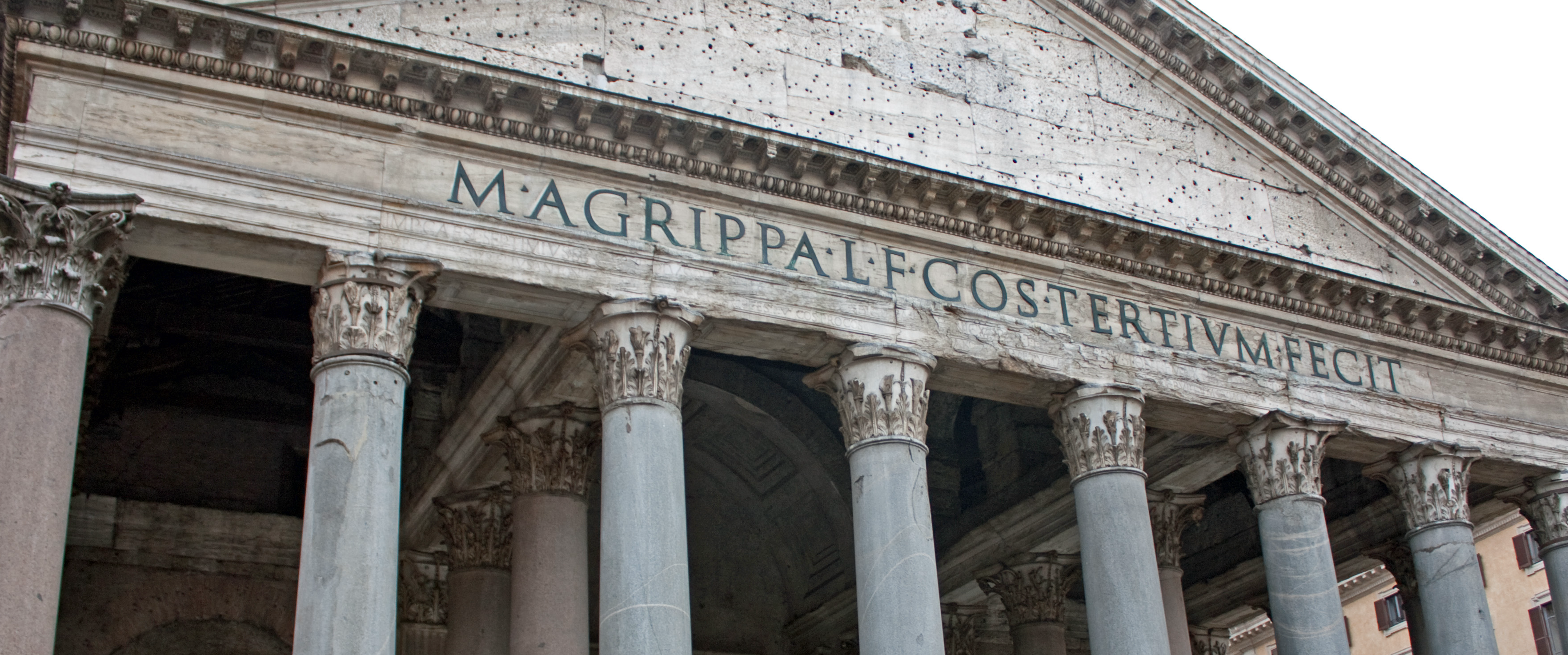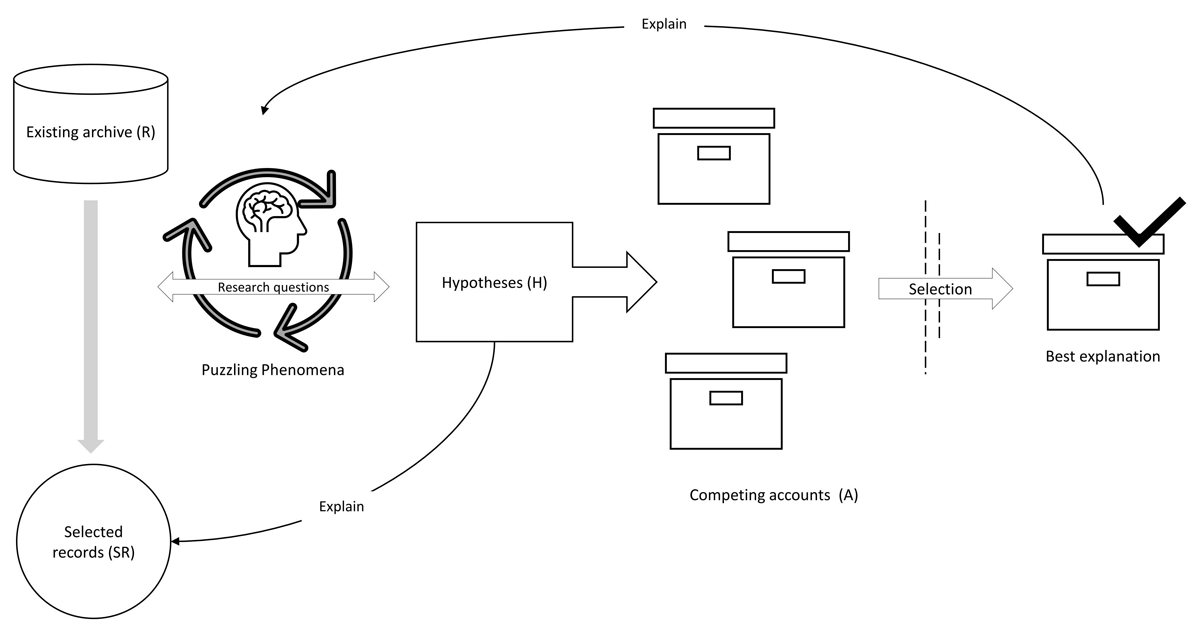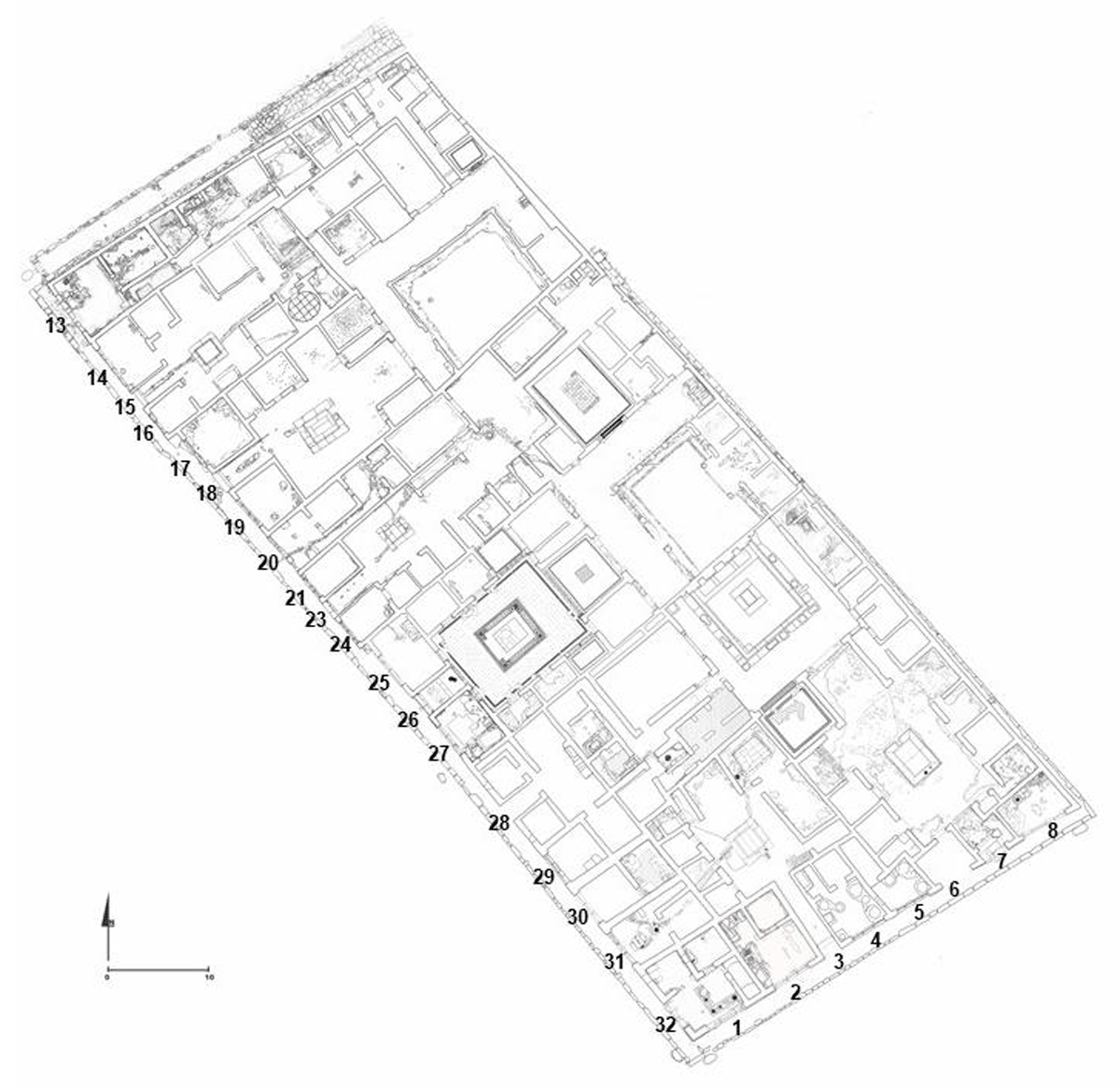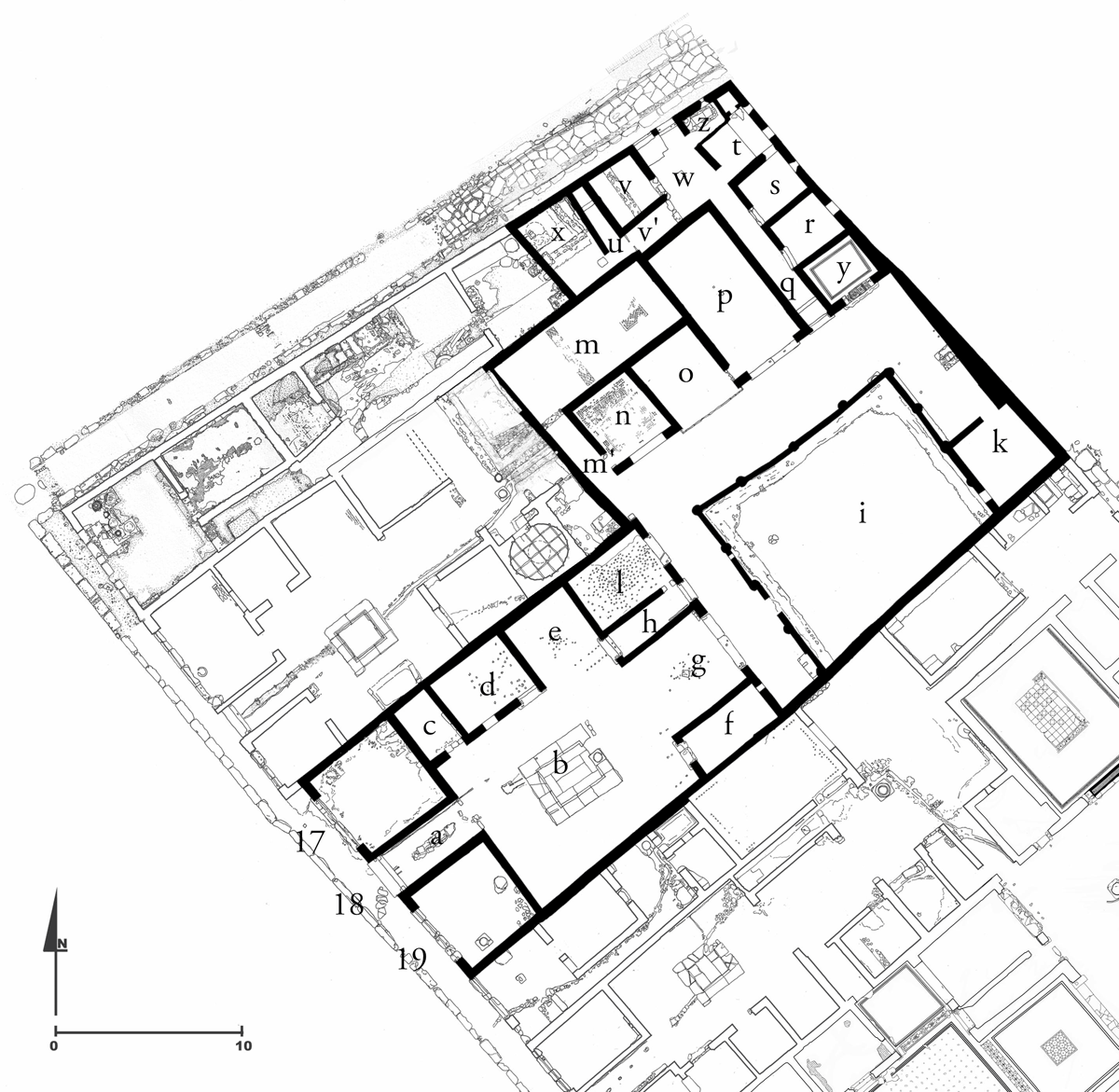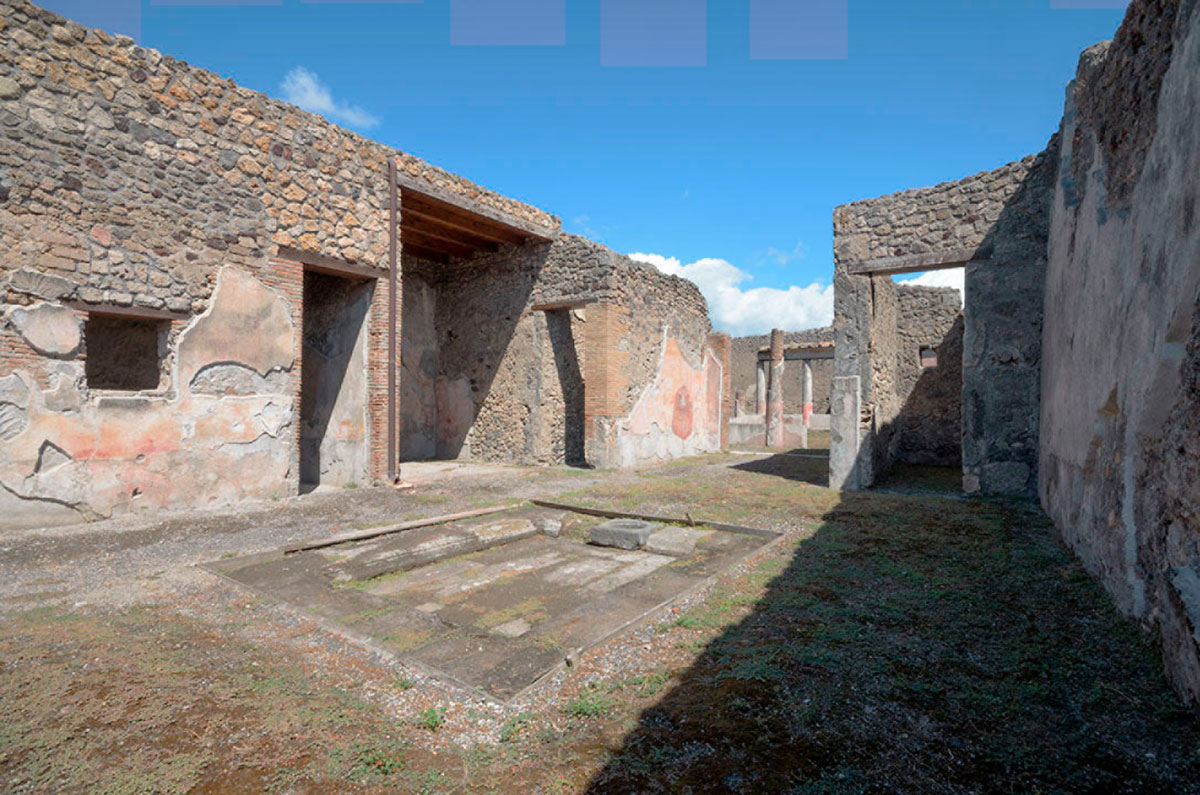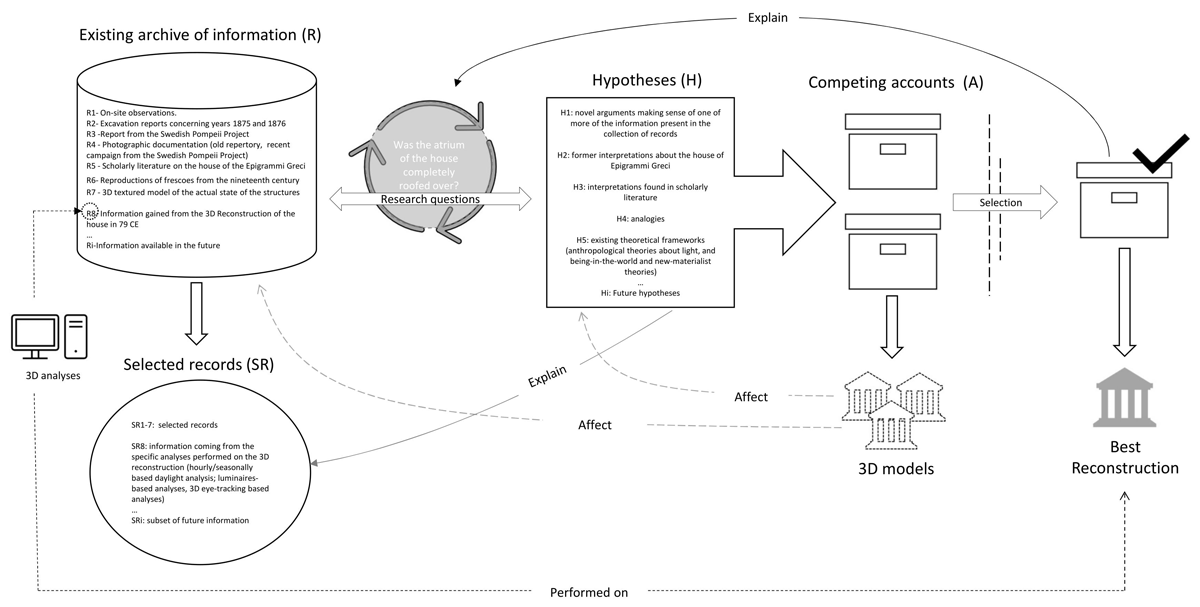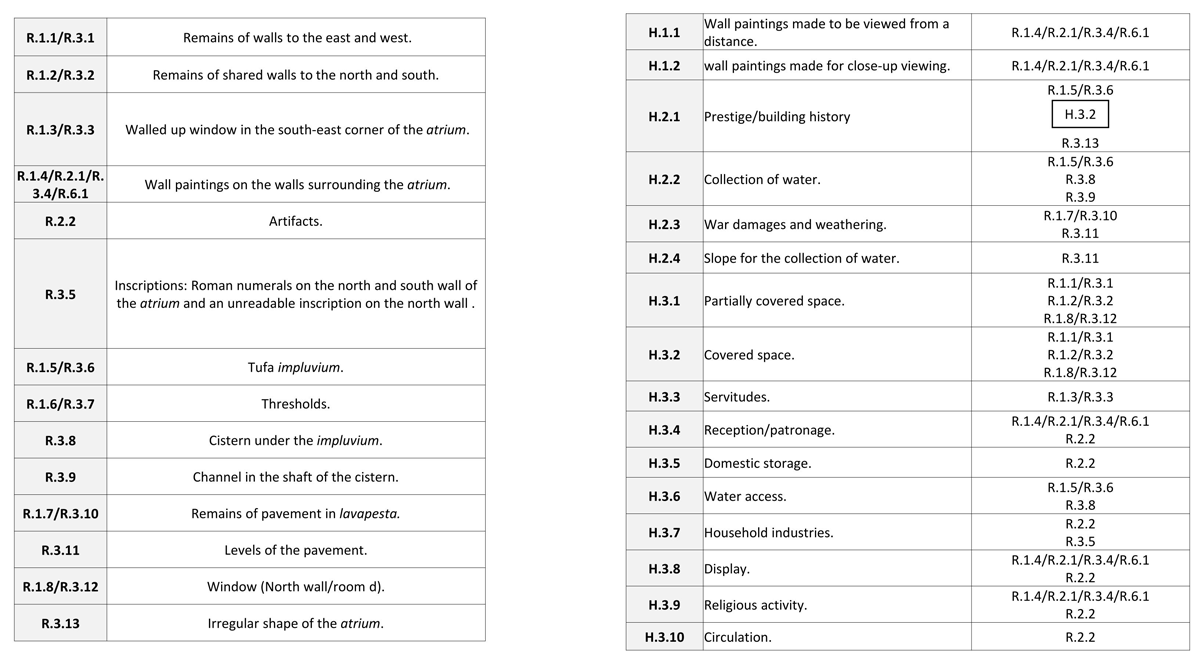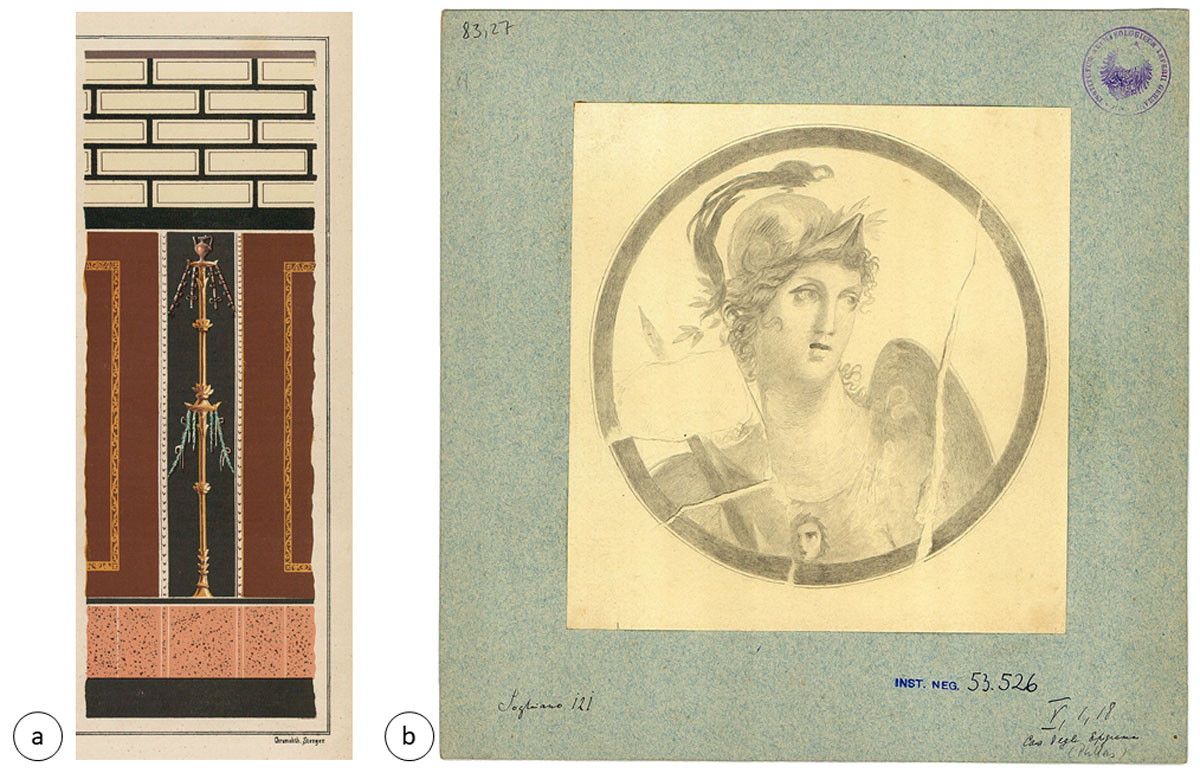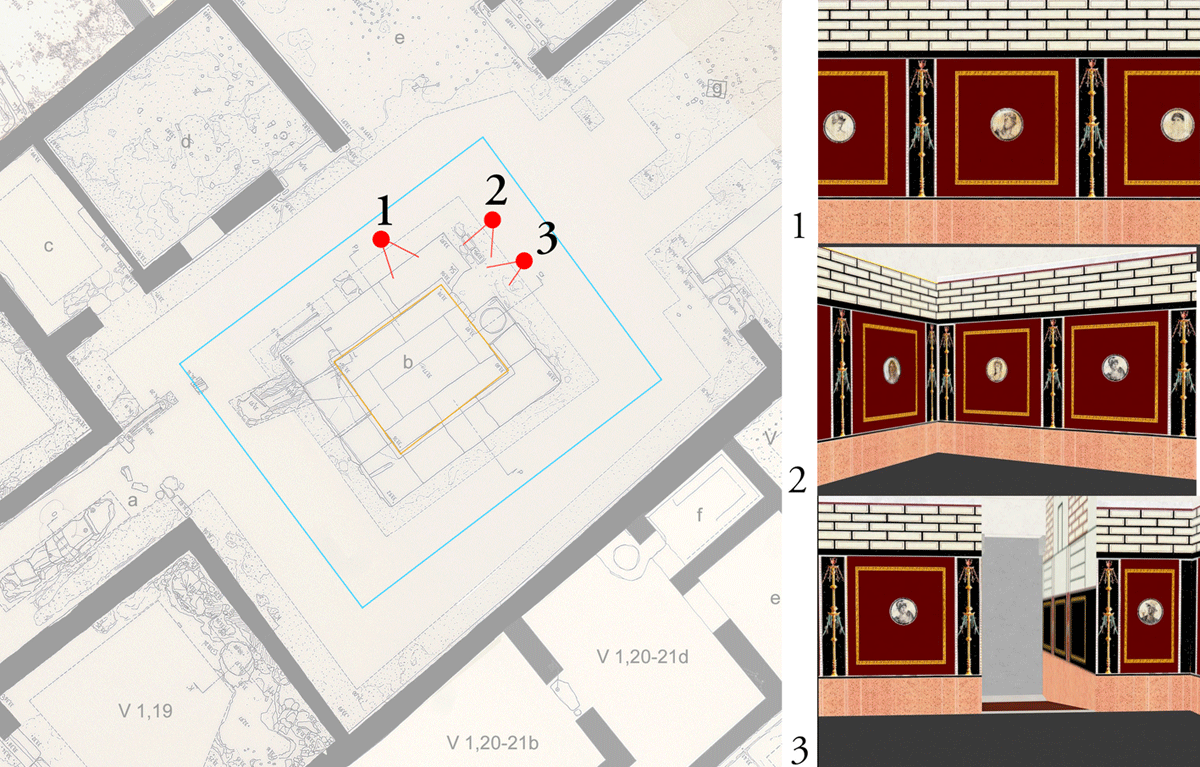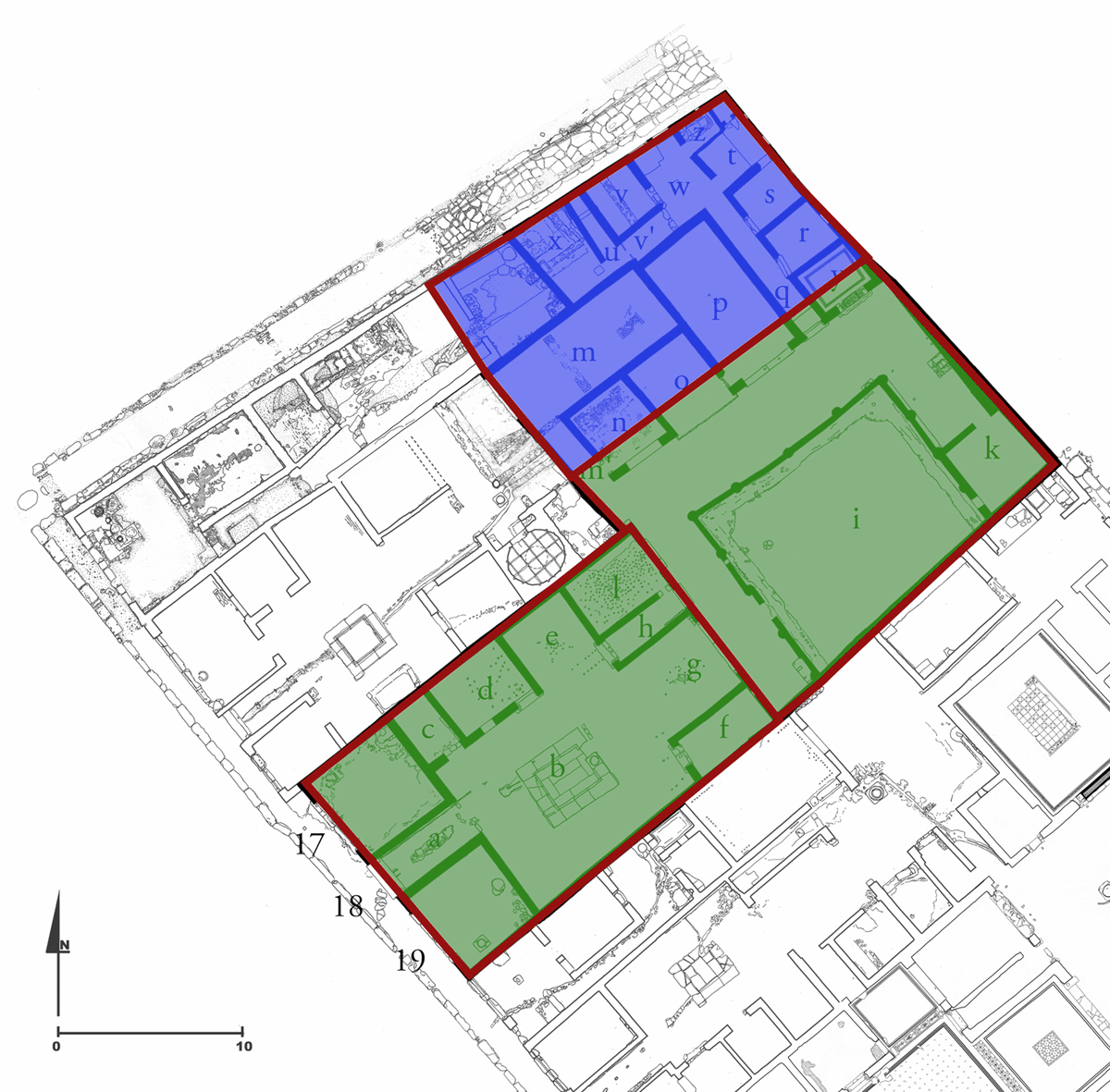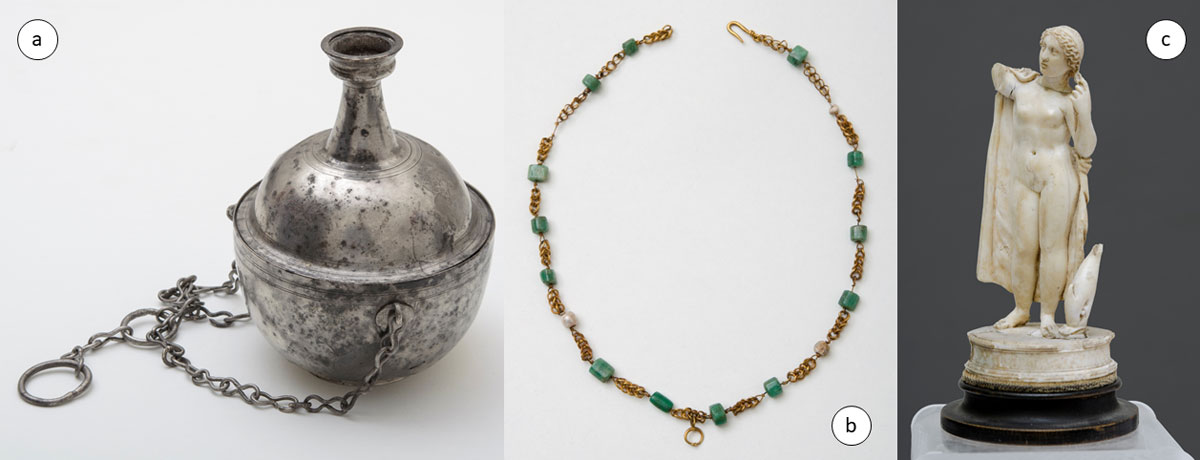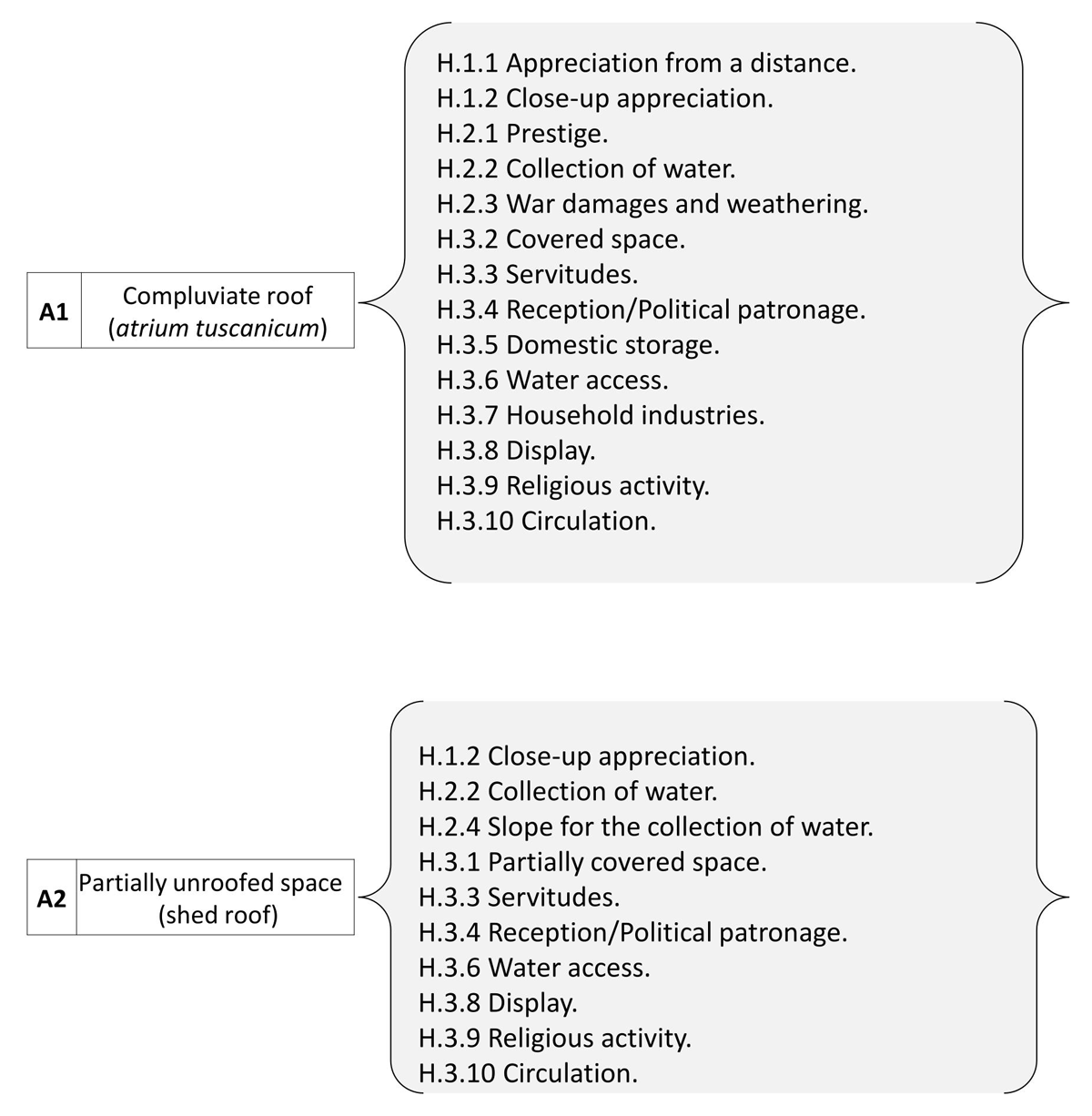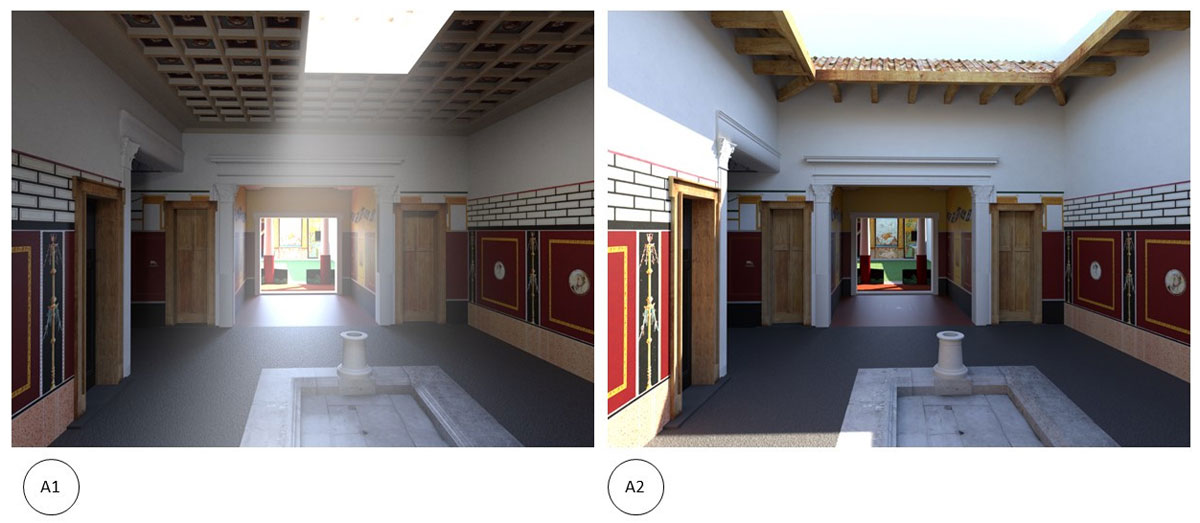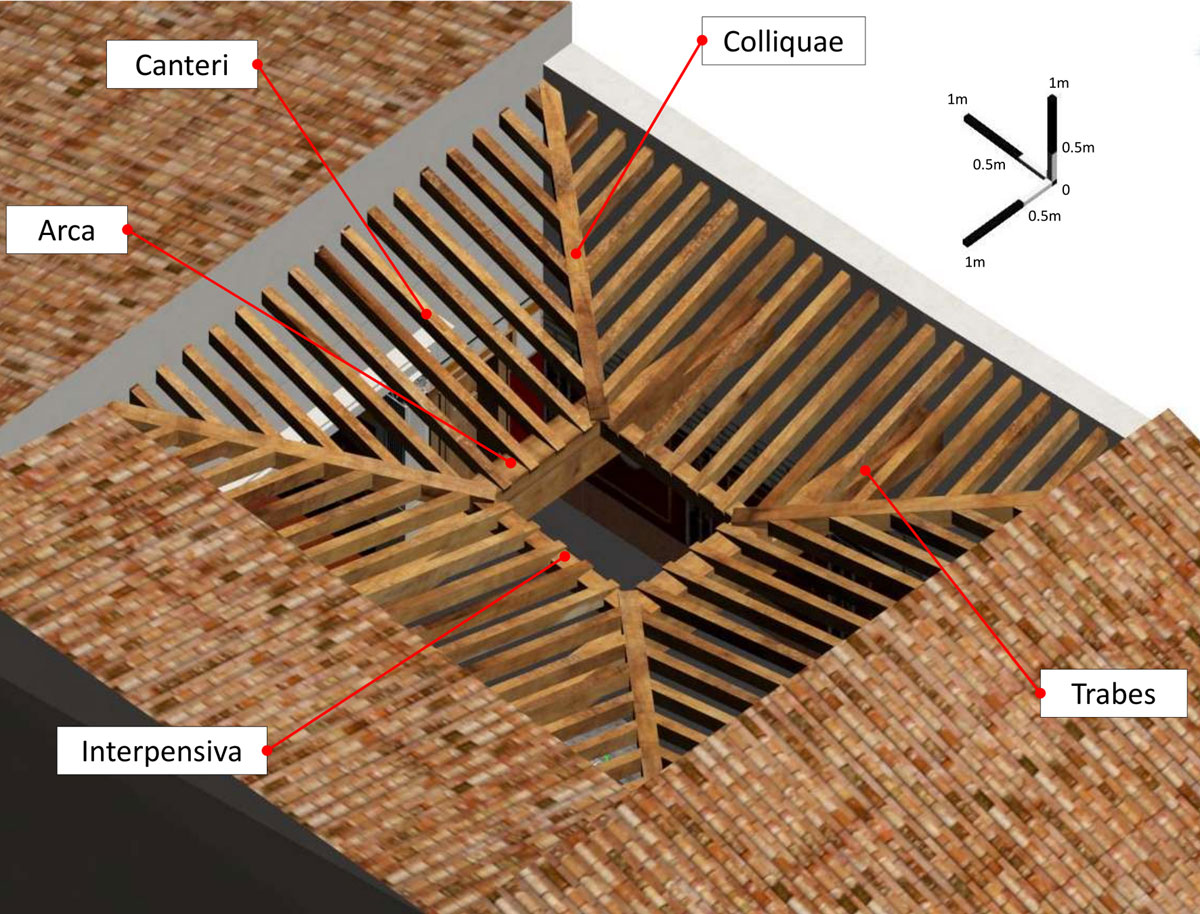Introduction
Over the last decades, an upsurge of studies concerning Roman domestic space has led to a critical reassessment of prior scholarship. Novel approaches have put major emphasis on the social dimension (Laurence and Wallace-Hadrill 1997; Wallace-Hadrill 1994; 1997; Zanker 1999). Concurrently, the emergence of new evidence from sites such as Cosa (Brown 1980; Bruno and Scott 1993) and Fregellae (Battaglini and Diosono 2010) has enriched a picture long dominated by the Vesuvian cities. Within this framework, the traditional nomenclature adopted by scholars to identify the spaces populating the Roman house has been critically reviewed (Leach 1997). Moreover, authors have confronted canonical views of the use of space as an intersection between literary text (Vitruvius’ treatise in the first place) and material evidence such as the content of excavated houses (Allison 2004). Ultimately, Andrew Wallace-Hadrill (2008; 2016) has criticised and dismissed the very idea of a progressive Hellenisation of the traditional atrium house (a house with a central courtyard), its consequent atrophy, and the following dispersal of its purely Roman characteristics.
Notably, some of these studies have advocated a reappraisal of the traditional evolutionary account of the atrium introducing the possibility for this space to be open at different stages of its life (Nappo 1997; Wallace-Hadrill 1997). Consequently, scholars have ceased to see the presence of the impluvium (central basin) as a decisive indication of a compluviate (inward sloping) roof. New questions concerning the roof systems of the atria, previously solved through the sole equivalence impluvium/compluvium, have emerged. In this context, Kemal Reha Kavas (2012) has called for a reassessment of the traditional atrium house with an emphasis on a reviewed epistemological approach with case-by-case scrutiny of the material evidence.
Concurrently, various scholars (Hanen and Kelley 1989; Fogelin 2007) have identified the inference to the best explanation (IBE) as an effective procedure for the interpretation of archaeological data. In my recent contribution to the European Journal of Archaeology (Campanaro 2021), I have stressed the IBE’s contribution to the improvement of transparency in the 3D reconstruction processes.
This paper proposes that IBE-based methodologies can be used effectively to re-evaluate the classic feature of the Roman house, the atrium. It addresses the question of whether individual atria were completely roofed over or not. In this regard, it illustrates the application of a novel IBE-based model for archaeological reasoning to the case study of the atrium of the House of the Greek Epigrams (V 1, 18) in Pompeii. It puts special emphasis on the three-dimensional (3D) aspects connected with the interpretation of archaeological data. Accordingly, it presents a 3D reconstruction as a product of the IBE-based process.
The atrium House Re-Thought
Over the last few decades, there has been a resurgence of studies concerning Roman domestic space (Wallace-Hadrill 2007; Bergmann 2012; Clarke 2013; Hales 2013; de Haan 2016). In this context, the atrium house has received much attention from scholars focusing on its origins and its development over time (McKay 1975; Carandini 1990; De Albentiis 1990; Dwyer 1991; Carandini and Carafa 1995; Ellis 2000; Sewell 2010; Anderson and Robinson 2018; D’Auria 2020; Esposito 2021). Concurrently, a growing body of literature has started critical scrutiny of its canonical form based on the Vitruvian description and the surviving material, especially from Pompeii (Tamm 1973; Evans 1978; Wallace-Hadrill 1997; Leach 1997; Allison 2004; Wallace-Hadrill 2007). Amongst those contributions, Birgitta Tamm (1973) has called for a more accurate study and comparison of archaeological material to provide a fresh look into the text by Vitruvius. Other scholars have emphasised examples that go beyond the canonical form presented by traditional accounts such as double atrium houses (Lauter 1975) and atrium houses without side rooms (Evans 1978). Furthermore, the critical work on the vocabulary of the Roman house by Eleanor Winsor Leach (1997) and Penelope Allison (2004) regarding the content and fixtures in excavated houses have suggested a more nuanced picture and multifunctionality of spaces.
In this context, Wallace-Hadrill (1997) has noted how a combination of Vitruvius’ descriptions and the material evidence from the Late Republican and Early Empire, notably Pompeii, has forged the account of the development of the Roman house. Scholars reading Varro (LL 5,161) and Vitruvius (6.3.1–2), have long embraced a connection between compluvium/impluvium and the atrium form to the point that, often, uncovered central courts have not been read as atria at all (Auer 2014: 34). The House of the Skeleton in Cosa is a particularly significant case in point. The complex, despite being equipped with an impluvium, was manifestly unroofed. The presence of driplines that define the contour of overhanging eaves are evidence of this feature (Bruno and Scott 1993: 117; Wallace-Hadrill 1997: 228; on similarities between Cosan complexes and Greek prostas houses, see Sewell 2010: 114). A study by Salvatore Ciro Nappo (1997) concerning the so-called row houses in Regio I and II in Pompeii similarly yielded significant results. In many respects, they resemble, yet with some exceptions, the typical atrium house, with fauces opening on a central space, a sequence of front rooms/central court/back rooms/garden, and the contrasting type of large/small or open/closed rooms (Wallace-Hadrill 1997: 222; see also Anderson and Robinson 2018: 54; on the row houses as a Roman adaptation of the Greek prostas layout, see Sewell 2010: 131). Nappo identified four types of dwellings featuring open courtyards, subsequently either converted into a covered space or retaining this configuration during the later stages of their life (Nappo 1997: 100, contra Esposito 2021: 205 who, by analogy with D’Auria 2020: 100–102, hypothesises testudinate atria featuring small terracotta compluvia). This is evident in the House of the Garden of Hercules (II 8,6), the Domus of Euxinus (I 11,12), Houses I 9,8; I 13,8; and I 14,3. Two interesting cases are provided by House I 15,1 for which stratigraphic tests confirmed the absence of a cistern under the impluvium, and House I 20,4 which, albeit equipped with an impluvium, at no stage was covered by a compluvium. According to Wallace-Hadrill (1997: 231–234), various houses in Reg. VI, ins. 5, the Casa Dei Fiori (VI 5, 19), Casa delle Forme di Creta (VII 4, 62), Casa di Ganimede (VII 13, 4), and the Casa del Gallo (VIII 5, 2) are all examples which could suggest that we may ‘be looking for the sort of traces of drainage-systems that would be compatible with atria with inward sloping roofs that extended no further than a walkway sheltered by overhanging eaves’ (233). Other examples would further contribute to defining the issue at stake. In House II 8, 4–5, close to Porta Nocera in Pompeii, a partially roofed central court equipped with a cistern lacked the traditional system of compluvium/impluvium. Thus, the water collected in the atrium would have been drained via the sloping pavement into a cistern close to the tablinum. Since more water would have been collected in the rear of the house, the main purpose of the atrium would have been that of a light well (Dentamaro 1997). In House I 11,14, the rectangular impluvium, with its longer side parallel to the street, had been covered with a shed roof and was illuminated through a circular opening (opaion; Tilloca 1997). Similarly, the atrium of House I 11, 9 would have been covered with a shed roof only during the last phase, whereas previously its function would have been that of a light well (Cerato 2000). Another interesting example can be found in Joanne Berry’s study of the House of the Beautiful Impluvium (I 9,1). During the last phase of the house, the atrium, roofed over at a previous stage, would have been left completely uncovered (Berry 1998, 53). Likewise, in the House of Amarantus (I 9,12), the atrium would have never been roofed (Wallace-Hadrill 1997: 223). In Fregellae Domus 4, which is lacking an impluvium, Giovanna Battaglini and Francesca Diosono (2010) identified the presence of an open roof of some kind, different from an atrium testudinatum.
The presence of open atria has, therefore, entered the scene as an alternative configuration, resisting the idea of the impluvium as the hallmark of a specific roof system. This would imply a new effort by scholars not to adopt reconstructions that assume that the atrium was necessarily covered. The question of the roofing of the atrium emerges as crucial in architectural terms but more importantly in connection with the epistemological choices underpinning the archaeological interpretation of the physical remains. According to Kavas (2012), the historiography of the Roman house has, until recently, applied idealist deductive methods to shape the implications of the material evidence to find confirmation for the Vitruvian descriptions.
Contemporary approaches should instead privilege a close study of the evidence and the stratigraphic information (for recent approaches to Vitruvius, see Milnor 2013; Nichols 2017: 90; Oksanish 2019). Thus, the reconstruction of the Casa della Caccia Antica (VII 4, 48) by Penelope Allison and Frank Sear (2002: 60) and that of the Samnite house by Anne Laidlaw et al. (2014: 265–268), who nevertheless place great reliance on the correspondence of the different parts of the house to Vitruvius’ rules, have to be considered interesting examples.
Kavas calls for the abandonment of the deductive method in favour of more empirical inductive approaches. Importantly, he notes that ‘material evidence yields the acquisition of three-dimensional architectural forms in the context of environmental problems and practical solutions while [the] Vitruvian text is based upon two-dimensional typological preconceptions’ (Kavas 2012: 144). He, therefore, suggests a critical review of the established historiography concerning the roof structure of the atrium house, with a major emphasis on the three-dimensional aspect connected to the advocated empirical inductive approach.
Real progress in the field would, therefore, require a ‘convergence’ of impulses often cultivated in isolation combining the application of novel theoretical frameworks with close scrutiny of the evidence (Wallace-Hadrill 1997: 219).
In the following, I will demonstrate how it is possible to respond to these calls, with the aid of a particular type of inference, the inference to the best explanation (IBE; Campanaro 2021), and a three-dimensional approach to the interpretation of the archaeological data. In this regard, the labels ‘open’/‘partially roofed’/‘unroofed’ used in this paper all refer to a form of central courtyard with ‘inward sloping roofs that extended no further than a walkway sheltered by overhanging eaves’ (Wallace-Hadrill 1997: 233).
An IBE Approach to the Archaeological Investigation
Inference to the best explanation, or abductive reasoning, has often been identified as one of the three major types of inference, together with deduction and induction. In deductive argumentation, the last proposition, inferred from the premises, is necessarily true if the premises are true. An application of such a ‘rigid standard’ is exemplified by Edith Evans’ analysis of the study by Noak and Lehmann-Hartleben about Houses VIII 2,39 and VIII 2,36 in Pompeii (1978: 175). These complexes, characterised by the absence of alae at the time of the eruption, would allegedly have included them at an earlier stage. According to Evans, the attempt of fitting the Vitruvian mould (the presence of the alae) resulted in a ‘bizarre interpretation’ whereby side rooms with a limited width of 1 m entail little or no use of those very spaces. In the case of an inductive argumentation, the truth of the conclusion can likely be inferred from the premises. In a very simple case, an archaeologist specialising in domestic architecture, having examined many cases of domestic structures, can use induction to suggest that most of them have a hearth (Fogelin 2007: 608). In abductive reasoning, the premises do not entail the conclusion like in a deductive pattern. The following example by Samir Okasha (2002: 29; Campanaro 2021: 413) may help to illustrate the concept: The cheese in the larder has disappeared, apart from a few crumbs/Scratching noises were heard coming from the larder last night/Therefore, the cheese was eaten by a mouse. Here, the conclusion can be inferred as the one that best explains the given set of data.
In recent years, a renewed interest in the structure of logical reasoning has stressed the importance of IBE as an effective pattern for the enhancement of archaeological argumentation (Hanen and Kelley 1989; Fogelin 2007; Smith 2015). In addition, I have highlighted (Campanaro 2021) how IBE-based methodologies can help build better arguments in archaeology and address issues of transparency of the processes underlying 3D virtual reconstructions in the field of cultural heritage. As noted by Lars Fogelin (2007), IBE and archaeology have long been silent companions. Despite this, one would be inclined to assume that archaeologists frequently make use of induction for their explanations. This is also evident, from Kavas’ arguments. Notably, Fogelin has pointed out that ‘traditional forms of induction often rely implicitly on inference to the best explanation’ (2007: 606). His case about analogical reasoning as discussed by Alison Wylie (2002: 136–153) is particularly relevant, considering the use of analogies often made in the process of 3D reconstructions for cultural heritage purposes. At the core of this form of reasoning is the notion that ‘some principles of connection exists between the traits being compared’ (Fogelin 2007: 607). This means that if A includes certain traits and B shares those traits plus some others, the latter can be attributed to A as well. Nevertheless, to establish this connection, analogical reasoning must employ IBE. Fogelin also addresses the case of statistical induction. A classic example suggests that by observing many black ravens one may conclude that all the ravens are black. The more prior observations, the stronger the induction. Nevertheless, this would be hardly tenable in the case of particularities of the past. Fogelin (2007), therefore, claims that adopting multiple lines of evidence may improve an argument, but not in terms of statistical induction. Though not solving the Humesian problem (a non-uniform world is conceivable, e.g. the sun may not rise in six million years), as no other system of reasoning does, IBE may address particularities of the past.
An IBE-Based Model
Despite its seminal contribution to the affirmation of IBE for archaeological reasoning, past literature has not offered specific examples for its application. Recently, Campanaro (2021) has defined an IBE-based model to record the complete chain of archaeological reasoning adopted for this paper. This model consists of four main phases (Figure 1): the selection of records (SR) from an existing archive (R), the formulation of hypotheses (H), the definition of competing accounts (A), and the selection of the best explanation amongst several plausible candidates making use of seven virtues: generality (a good explanation should be employed for a wide array of phenomena); modesty (the explanation should not overreach); refutability (explanations should be refutable); conservatism (the explanation should not principally aim at overthrowing well-established principles); simplicity (explanations should not be more complicated than necessary, e.g. Occam’s razor,); empirical breadth (a good explanation should address several empirical phenomena and not be contradicted by others) and multiplicity of foils (the more ‘layers’, the better the explanation; Quine and Ullian 1978; Fogelin 2007; Campanaro 2021).
An IBE-Based Approach to the Roofing of the House of the Greek Epigrams
The House of the Greek Epigrams (V 1,18.11–12) is located in the northern part of the Insula V 1 in Pompeii (Figure 2). First excavated in 1875 and greatly damaged during the Second World War as well as the 1980 earthquake, this complex has given rise to many questions of great importance for modern archaeological research, still far from being thoroughly answered (Staub Gierow 2007). New excavations and accurate studies aimed at understanding the building history of the house, the function of the rooms, and the daily life of their owners have been carried out as part of the Swedish Pompeii Project (http://www.pompejiprojektet.se/project.php; Robinson 2007; Robinson 2008: 126–28; Staub Gierow 2005; 2007; 2008; 2009: 216–17; Leander Touati et al. 2018). Interestingly, the House of the Greek Epigrams is the only house of this insula that was not evacuated before/during the eruption of Mount Vesuvius and where, thus, an abundance of artefacts has been brought to light.
In the following, I will analyse specifically the roofing of the atrium (b) of the House of the Greek Epigrams (Figures 3, 4) by employing an IBE-based methodology.
In a first step, all records concerning the main topic of the investigation are collected (Figure 5: SR), in particular, those concerning the question of whether the front hall (atrium) of the house was roofed over or not during its last phase. Accordingly, elements from the existing documentation (R) that concern the state of the house are selected and added; these comprise recent and past excavation reports (except for any related interpretations, which form part of the hypotheses group) and photographic documentation including reproductions from the 19th century, etc. When multiple sources are present, they are distinguished using the format Ri/Rj/…/Rz; for example, in the case of the wall paintings described in the reports of the Swedish Pompeii Project and appearing in previous photographic documentation, reproductions, and reports from the 19th century: R.1.1/R.2.5/R.5.1 (Figure 6).
In a second step, hypotheses (Figure 6 H) are formulated. For the case study in question, these are:
-
H.1.1: wall paintings were made to be viewed from a distance; H.1.2: wall paintings were made for close-up viewing
The walls surrounding the atrium are decorated with fourth-style paintings in a tripartite structure, now completely faded (Figure 7a). The lower part consisted of a simple marble imitation, with a pink background and a scattered pattern in red and probably grey (Staub Gierow 2017c). The middle zone, separated from the lower part by a black line, was covered in large red panels alternating with narrow black fields, each decorated with a candelabrum. In the centre of the red panels, each with an ornamental frame, medallions with busts of different gods were depicted (Figure 7b). Starting from the south wall, Mars and Venus, the adulterous lovers, faced each other with Vulcan, Venus’ husband, in the middle. At the corner between the south and the west wall, the Capitoline triad, Minerva, Juno, and probably Jupiter (Pugliese Carratelli 1991: 546 suggested this possibility, as the medallion was already missing at the time of excavation) was positioned. The association with liminality explains the presence of Minerva and Mercury on the left and right sides of the entrance. The dimension of the medallions (0.41–0.42 m in diameter, according to Mau 1877: 19) could suggest that they were designed to be viewed from a shorter distance, as isolated elements. Nevertheless, their position in relation to each other also entails the possibility that they might have been appreciated from a longer distance as groups of deities. Their contextualisation in the 3D model has helped to formulate this hypothesis.
Figure 7(a) Detail of the wall decoration of the atrium (Source: adapted after Emil Presuhn 1882: Tab. II-IV). (b) Atrium, west wall, section south of vestibule, middle section, detail: medallion painted on red ground, graphical reproduction of the bust of Minerva facing north (Source: DAI-Rom, Archivio, A-VII-32-026, arachne.dainst.org/entity/3563685).
There is reason to argue for the coexistence of two levels of looking at the decorative program depending on the relative distance of the viewer in the atrium. Interestingly, a distance sufficient to have the deities visually grouped together could suggest use of the space in its entirety, seasonally independent, and, therefore, the space being completely roofed over (Figure 8). Nevertheless, visitors might have inspected and visually connected the deities at close range under the protection of a partial roof. Accordingly, two hypotheses can be formulated concerning the presence of wall paintings in the atrium: H.1.1: wall paintings were made to be viewed from a distance; H.1.2: wall paintings were made for close-up viewing.
-
H.2.1: prestige/building history
Investigations carried out as part of the Swedish Pompeii Project have identified several phases within the building history of the house (Staub Gierow 2005; 2007; 2008). Notably, a recent study (Leander Touati et al. 2021) with a special focus on perimeters and boundaries between properties conducted on the whole of Insula V 1 has provided novel insights concerning the building history of the insula. Summarising their work, four main building phases of the house can be identified. During the first phase, dating back to around the second century BC, the complex consisted of separate units, which were later to become the House of the Greek Epigrams. Interestingly, return corners of the neighbouring properties to the north and the south would suggest low utilisation of the area, which will later become the atrium and the peristyle (Figure 9 i). The presence of windows worked into the neighbouring walls, borrowing light from those very spaces, would further support the possibility of a plot ‘mainly open to the sky, in the Samnite period’ (Leander Touati et al. 2021). Around 40–30 BC the units with entrances from Via di Vesuvio and Via delle Nozze D’argento would have been merged, and a peristyle would have been added. This is also the time when the eponymous room y, decorated with late second-style paintings, was created. The complex gained most of its present form at this time. According to Leander Touati et al. (2021), an almost complete redecoration in the fourth style would have taken place during the third phase, dated to the Claudian or Neronian period (on the simultaneous presence of styles in Pompeian wall paintings, see Lorenz 2015). Access to the public aqueduct would already have been granted at this time. In this context, Staub Gierow (2008: 97) has suggested the presence of a fountain with a basin in the peristyle. Similarly, a round metal tube in the middle of the impluvium could indicate the presence of a statue or a fountain, as proposed by Frank Sear for the House of the Figured Capitals (VII 4, 57; Sear 2006: 197). The distribution of scant remains of lead pipes might favour the first possibility. The last phase, characterised by hasty and disorderly work, would relate to the aftermath of the earthquake in AD 62. This phase would have comprised minor changes, the most notable being the closing of the southernmost intercolumnia in the eastern portico to create room k.
Figure 9The picture illustrates the earliest use of the area later to become the House of the Greek Epigrams. In blue is the hypothesised northeast building. In green, low exploited areas. The red lines indicate possible property boundaries. (Source: details after Leander Touati et al. 2021, courtesy of the authors).
A major change in the facies of the complex is evident in at least two phases, dating back to around 40–30 BC and the Claudian/Neronian period. These two timeframes could relate to events of great relevance to the social dynamics of the town. In the first case, Caesar’s victory in the Civil War of 45 BC would have led to a replacement of the Pompeian families who supported Pompey and the senatorial authority (optimates) with an influx of new families (gentes; Pesando and Guidobaldi 2018: 9; on the problematic use of the terms populares and optimates see Robb 2010). In the second case, during the Claudian period, political life in Pompeii would have undergone some institutional crisis, possibly due to the imperial desire to reform the local government (ordo; Pesando and Guidobaldi 2018: 11; Clarke 1991: 165). New family names, once again, entered the political stage in Pompeii.
Therefore, a renewed urge to manifest prestige through the architecture and decoration of the house would have imbued those building periods with luxury adopted as a marker of a Roman identity (Wallace-Hadrill 2016: 185). If one considers the possibility of the atrium being open to the sky during an earlier phase, the presence of a complete roof (possibly including a decorated coffered ceiling), would have thoroughly complied with the decorative desiderata. In this context, the label ‘complete roof’ comprises all typologies described by Vitruvius (Tuscan, Corinthian, tetrastyle, displuviate, and testudinate) as well as the shed-roofed space with an opaion and the flat roof identified by Spinazzola (1953). A preliminary process of coherence-making (Campanaro 2021) has helped to refine the number of initial hypotheses as early as this stage. In this context, the tetrastyle and Corinthian solutions can be discarded as no columns have been found. Similarly, a testudinate roof and a shed roof would be hardly tenable, due to the dimension of the atrium (Vitruvius, De architectura 6.3.2). A displuviate roof would be equally unfeasible because of the major issues connected with the drainage of water (Vitruvius, De architectura 6.3.2). A flat roof, on the other hand, would appear to be a bizarre solution, requiring major technical efforts whilst preventing a complete utilisation of the impluvium. A roof of the kind of the atrium tuscanicum would remain the most coherent solution amongst the hypotheses for a completely covered space. The roofing of the atrium, therefore, might have coincided with one of the two building phases. Two observations may help to refine this picture. According to Staub Gierow (2009), the lava thresholds of the rooms surrounding the atrium would belong to the first building phase of the house and the relative rims would suggest that the doors opened inwardly. This would have protected them from water, especially in the case of an open courtyard. Nevertheless, this feature might also have helped to create privacy, isolating the cubicula (c, d, f) from the central space, and preventing the open shutters from invading the space of the atrium. The tuff impluvium, of type B1 described by Fadda (1975), would date back to the second half of the second century BC. No traces of an earlier pavement have been found in the atrium, which revealed scant remains of the second-style lavapesta floor. This could indicate that the impluvium may have been a late installation, as is the case in the neighbouring ‘bakery’ (V 1, 14–16; Boman and Nilsson 2015). An argument can therefore be made for the atrium to have been unroofed during the earliest phase of the history of the house. This would support the scenario of a low utilisation of the area. An impluvium would have been added at a later stage when the house received its second-style decoration. Accordingly, a complete roof and a coffered ceiling would have been built in coherence with the new lavish decorative program.
A hypothesis can be formulated about the need to enhance prestige (H.2.1) that would explain the presence of a tufa impluvium (R.1.5/R.3.6) and the possibility of the space being covered (H.3.2). The irregularity of the space (R.3.13) could be explained by the fact that it was an ‘in-between area’ defined by two different phases of construction, which concerned the neighbouring areas of the house to the north and south (Leander Touati et al. 2021).
-
H.2.2: the collection of water
This previous observation could also explain the presence of an impluvium with a terracotta pipe functioning as an outlet towards the street as well as the cistern underneath the impluvium, where the water was collected. Remains of a channel found in the shaft at a depth of 0.79 m (32.69 m a.s.l.) suggest its function as an outlet towards another water collector (Staub Gierow 2017a). The absence of a puteal, not found at the time of excavation, could be justified by the complex post-depositional history of the site. The need to collect water (H.2.2) would, therefore, explain the presence of a tuff impluvium (R.1.5/R.3.6), and the cistern under the impluvium (R.3.8).
-
H.2.3: war damage and weathering; H.2.4: slope for the collection of water
The weathering process, a consequence of the site being exposed after its excavation at the end of the 19th century, could explain the scant remains of the lavapesta pavement in the atrium. According to Margareta Staub Gierow (2017b), the damage related to the Allied bombing in 1943 would explain the bad state of preservation and the apparent sinking in the area of the impluvium. However, this would not necessarily rule out the possibility that the pavement uniformly sloped towards the impluvium, supporting the hypothesis of partial roofing of this space. Soundings and the presence of a terracotta pipe draining the water collected in the central pool would argue against the presence of an earlier pavement. Thus, two different hypotheses can be put forward explaining the physical state of the pavement in the atrium and its sinking: war damage and weathering (H.2.3) and the possibility that it had received this feature for the collection of water (H.2.4).
-
H.3.1: partially covered space; H.3.2: covered space; H.3.3: servitude
The remains of the walls delimiting the front hall would be compatible with both complete and partial roofing. In the first case (compluviate roof of the type of an atrium tuscanicum), a couple of main beams would have stretched over the entire width of the front hall, from the wall delimiting the northern cubicula (rooms c, d, and e) to the southern wall looking onto the Taberna V 1,20–21. This would have entailed some form of building servitude (right under which one person’s property is subject to use or enjoyment by another, e.g.tigni immittendi, the right to attach a beam or any building materials to the walls of a neighbour, or oneris ferendi, the right to use the wall of a neighbour to support one’s own edifice, Saliou 1994: 37–71) involving the neighbouring Taberna V 1,20–21. Thus, the owner of the House of the Greek Epigrams would have been allowed to use the shared wall to bear the weight of the structure of the roof. In the second case, a partially roofed space would have involved the use of smaller beams. However, even in this case, some form of servitude would have been required. A third possibility, a compluviate roof with two main beams oriented towards the wall separating the atrium and the tablinum, has been considered, thereby ruling out the possibility of using walls shared with the owner of the Taberna V 1,20–21 for the main beams. Although an interesting proposition, this alternative would not have exempted the owner of the House of the Greek Epigrams from asking for some form of servitude to build the remaining part of the roof structure. Furthermore, this would have entailed the use of longer, higher, and thus more expensive beams to roof the same space.
As for the irregular shape of the central court, a canopy or a partial covering would have represented an easier solution. Nevertheless, irregularly shaped atria would have been anything but uncommon in Pompeii. A compluviate roof of the type of atrium tuscanicum would, therefore, have been an equally feasible possibility.
The presence of a window in room d, opening directly onto the atrium, would have been justified both in the case of an unroofed atrium, as is the case with the House of the Beautiful Impluvium (I 9, 1), and a compluviate roof, as can be seen in the House of the Bear VII 2,45 and the House of the Ephebe I 7,11. Notably, the only difference would have been in the amount of light reaching the rooms through the window.
Therefore, the remains of the walls can be explained by two different hypotheses. The necessity to bear the weight of a complete roof (H.3.2) or simple projecting eaves (H.3.1). The presence of a window in room d (R.1.8.; R.3.12) would be necessary to bring light into an otherwise too dark space. This would have been best achieved with a simple partial roof and still possible with a complete roof of the type of atrium tuscanicum. The presence of a walled window in the southeast corner would be explained by the need to let light in as a form of servitude (H.3.3), right to light or ius luminis immittendi (Saliou 1994: 53–61).
-
H.3.4: reception/patronage; H.3.5: domestic storage; H.3.6: water access; H.3.7: household industries; H.3.8: display; H.3.9: religious activity; H.3.10: circulation.
The presence of inscribed numerals and tally marks on the south and north walls of the atrium (Lundqvist n.d.) may indicate the use of these walls to keep track of quantities (Bailey 2013: 158) or as a ‘clever addition to a conversation’ (Benefiel 2010: 114); none argue against the possibility for this space to be unroofed.
The distribution of artefacts across the atrium (Table 1) can be analysed with the recent research concerning the functionality of domestic spaces (Table 2) in mind. Building on Allison (2004), Berry (2007) highlights how artefacts can shed light on the complexities of domestic life at the time of the eruption in 79 CE. Under normal circumstances, storage was possibly the most common use for domestic space and different areas were probably used in many more ways than suggested by literary sources. A lock plate (scudetto di cassettina) found in the atrium of the house, could point to the presence of a wooden chest. Some of the artefacts found in the same area, amongst them a necklace of emeralds and pearls (Figure 10b) could have been stored in this chest. The presence of such containers was very common in Pompeian houses (Allison 2004), as was their use to collect a variety of different objects.
Table 1Artefacts found in the atrium (room b) of the House of the Greek Epigrams (after Giornali di Scavo dei Soprastanti, handwritten version held at the Archivio Storico della Soprintendenza di Napoli).
Artefact Type Artefact type (English translation) Notes (Giornale degli Scavi 1875–1876) Notes (English translation, measurements in mm). Material Lagena Jug Una lagena ad un manico distaccato, Al. m 240 One lagena with a detached handle, Height 240. Silver Moneta Coin Una piccola moneta di cui ne manca un pezzo One small coin missing a piece Bronze Scudetto di cassettina Lock plate Uno scudetto di cassettina circolare, col foro per la chiave e con sei teste di chiodetti nel giro. One round lock plate, with a keyhole and six heads of nails, Diameter 51. Silver Catenella Necklace Una catenella a piccole maglie intermezzata da N° tredici smeraldi forati a da tre perle, una delle quali è molto corrosa. In un estremo vi sta un uncinetto dello steso metallo, e dal centro pende un piccolo anelletto. L m 350 One necklace with small links interspersed with thirteen pierced emeralds and three pearls, one of which is very corroded. At one end is a hook of the same metal, and from the centre hangs a small ring, length 350 Gold Lucerna Lamp Una lucerna ad un lume col manico ad anello spezzato. L senza il manico m. 120 One oil lamp with one nozzle lamp and a broken handle, Length without the handle 120 Bronze Patera Flat bowl with handle Una patera L m 262 Length 262 Bronze Amforetta amphora Un’amforetta con iscrizione One small, inscribed amphora Terracotta Figure 10(a) Silver container for perfumes or balsamic substances part of the toilet set (Naples, National Archaeological Museum, inv. 110841). (b) Gold necklace with small links interspersed with thirteen pierced emeralds and three pearls (Naples, National Archaeological Museum, inv 110869). (c) Ivory statuette of Venus (Naples, National Archaeological Museum, inv. 110924). (Source: Courtesy of the photo archive of the National Archaeological Museum of Naples (MANN)).
As stated by Allison (2007), the occurrence of certain activities in the atrium is also evidenced by the distribution and typology of artefacts found in the rooms opening onto the central court (Table 3), which frequently served as storerooms as indicated, for example, by the presence of six terracotta lamps in room c. Likewise, the concentration of precious finds in the ala (e), including a complete silver service used for serving food (argentum escarium) and a toilet set (argentum balneare; De Carolis 2006. Figure 10a), would identify this zone as a storage/display room. The atrium might therefore have housed different activities (Table 2), depending on the time of the day (Bergmann 2012: 231). As for the use of the atrium as a place for eating, Lisa Nevett refers to Servius (I.637,726) quoting Cato and Ovid (Metamorphoses 4.763) with the caveat that ‘it is not entirely clear whether these sources refer to the contemporary house, or only to some (possibly mythical) past pattern of behavior’ (1997: 290). More generally, Allison notes that ‘if there were no guests to entertain, cooks, servants, and slaves might have provided meals for the various members of the household when and where they chose’ (2009: 25) but also that ‘lacking is evidence for food preparation and eating in this part [the atrium] of the house’ (Allison 2007: 273). On the same topic, from a multisensory perspective, Hannah Platts highlights that ‘evidence for eating in the atrium-tablinum complex includes finds of serving and tableware’ (2020: 120), although a difficulty remains in distinguishing between use and storage. In this context and for the specific purpose of this study, the possibility of food consumption in the atrium, although it cannot be excluded in principle, does not figure as a hypothesis in its own right.
Table 3Artefacts found in the rooms opening onto the atrium (b) (after Giornali di Scavo dei Soprastanti, handwritten version held at the Archivio Storico della Soprintendenza di Napoli).
Room Artefact type Artefact type (English translation) Count Material c Monetina Small coin 1 Silver c Suggello Signet ring 1 Bronze c Calamaio Inkwell 1 Bronze c Piccola chiave Small key 2 Bronze c Pinzetta Tweezers 1 Bronze c Monete medie Coin (average dimension) 7 Bronze c Bottiglia Bottle 1 Glass c Bottiglina Small bottle 2 Glass c Caraffinetta Small jug 3 Glass c Tazza Cup 1 Glass c Tazzolina Small cup 1 Glass c Vasettino Small vase 1 Glass c Lucerna Lamp 6 Terracotta c Tazza Cup 3 Terracotta c Accetta Hatchet 2 Iron c Martellina Pick 1 Iron d Base di mobile Base for furniture 3 Bronze e Strigile Strigil 3 Bronze e Braccio per sostegno di lampada Lamp holder 1 Bronze e Cornicette di lamina Sheet metal 1 Silver e Caraffinetta Small jug 1 Glass e Orecchini Earrings 2 Gold e Gallone Ornament 1 Gold e Coppa Cup 1 Silver e Piattino Small plate 7 Silver e Tazza Cup 4 Silver e Tazzetta Small cup 4 Silver e Cocchiarino Small spoon 4 Silver e Specchio Mirror 1 Silver e Strigili Strigil 2 Silver e Forma di pasticceria Pastry mould 2 Silver e Conca baccellata Ribbed Bowl 1 Silver e Piedi Foot (of a container) 4 Silver e Manico di vasettino Jar handle 1 Silver e Laminette Piece of sheet metal 1 Silver e Vasettino frammenti Fragments of a small cup – Silver e Tubo Broken pipe 1 Silver e Paletta Small shovel 1 Bronze e Caldarino Small Cauldron 1 Bronze e Monete Coin 3 Bronze e Mascheretta Small decorations in shape of masks 7 Bronze e Serrature Lock 3 Bronze e Frammenti Fragments — Iron g Statuetta di Venere Statuette of Venus 1 Ivory g Basetta Small base 1 Silver g Patera Flat bowl with handle 1 Bronze g Vaso Vase 1 Bronze g Nasiterno Bottle with three-lobed mouthpiece 1 Bronze g Statuetta di Giove Statuette of Jupiter 1 Bronze g Bottiglia Bottle 5 Glass The lack of a lararium in this area of the house would not exclude the possibility that religious activities took place in this space, as the presence of a bronze statuette of Jupiter and an ivory statuette of Venus Anadyomene (Figure 10c) in the tablinum might imply. As suggested by John Clarke (2013: 347), the atrium could be used for many rituals around rites of passage, collectively called sacra privata, such as birth, the coming-of-age, weddings, and the mourning of the dead.
Accordingly, the presence of a complete roof would be in favour of the purported multifunctionality of these spaces. Conversely, depending on the season, activities under a partially roofed space would have been very limited, mainly facilitating circulation towards the different surrounding areas.
The presence of artefacts would, therefore, be the result of different activities performed in the atrium (H.3.4: reception/patronage; H.3.8: display; H.3.9: religious activity) but could also point to storage (H.3.5: domestic storage) and other activities (H.3.7: household industries). The concentration of artefacts in the room opening onto the atrium would also identify this as a space for circulation (H.3.10: circulation). The presence of a tuff impluvium would be explained by the need to have access to water (H.3.6).
Accounts
The third stage of the IBE-based model consists of the development of accounts, combining one or more of the hypotheses defined in the previous stage and their possible refinement. This involves a process of coherence-making through subtraction, addition, or reinterpretation, such as subtracting elements from an incoherent set or adding elements to increase coherence. In the following, I will illustrate this process through the workflow of the reconstruction.
Figure 11, A1 and A2, represents two different accounts explaining the records in SR, including a subset of hypotheses. At present date, two alternative 3D models of the accounts have been created (Figure 12 a–b). The first account presents the possibility that the front hall of the House of the Greek Epigrams was covered with a roof structure of the type of the atrium tuscanicum. The second account, building on the work by Nappo (1997) and Wallace-Hadrill (1997), would instead suggest the possibility that the central space was only partially roofed over.
The three-dimensional nature of these structures, which has very often been taken for granted, especially in the case of the atrium tuscanicum, has required further investigation. In this regard, Jean-Pierre Adam (1994) has devoted much effort to trying to illustrate technical aspects concerning the roofing of spaces in the Roman house. Simpler solutions such as shed roofs (and partially roofed atria would enter into this definition) can be more straightforwardly reconstructed (Adam 1994: 207). Conversely, identifying the elements composing the structure of a compluviate space has been more challenging. Over time, scholars have dealt with this topic in connection with monument protection and conservation practices (Salassa 1999; Pierattini 2009; Bergamasco et al. 2018). Chiara Salassa (1999) analyses the works of scholars who have visited Pompeii since its excavation began in 1748. Amongst those studies, the French scholar François Mazois (1812), offered an innovative rendering of the structure of the atrium tuscanicum, with each element corresponding to a specific Vitruvian label. This model had been generally accepted and Johannes Overbeck (1968 [1866]) was alone in his critical investigation of Mazois’ work. Whilst the latter described the secondary beams (interpensiva) framing the opening of the compluvium (arca) as resting on the main beams (trabes), Overbeck imagined the interpensiva notched to the main beams. As noted by Roger Ulrich (2007: 167–172), several details do not argue in favour of the solution illustrated by Overbeck, such as missing details regarding the joinery, Vitruvius’ preoccupation with the loads imposed (6.3.1), and the use of supra in the description of the arca (6.3.4), as resting on the main beams, and making ‘better structural sense’ (Ulrich 2007: 171). For this specific study, the solution adopted in the 3D reconstruction of the roof uses the studies of Mazois and Ulrich (Figure 13). Notably, Alessandro Pierattini (2009) addresses the technical issue of the roofing of atria with irregular forms. Suggesting a corrective to the solution of the tegulae colliciae (special angular tiles, see Salassa 1999), he stresses how the evidence of not-square atria must admit tigni colliquiarum (corner beams creating the valleys) not necessarily meeting the walls in the corner.
The structure of the atrium tuscanicum of the House of the Greek Epigrams with terminology from Ulrich 2007 (Source: author).
The pitch of the roof creates another relevant challenge. Various scholars have suggested an inclination of the roof ranging from 15 to 20 degrees, to prevent the roof tiles from sliding down, water from backing up, and wind suction (Rook 1979: 295–96, Gerding 2013: 142). Nevertheless, the position of the main beams, bearing the weight of the compluviate roof, in the wall would still remain a major issue. The dimensions of the atrium of the Casa del Bicentenario (V 15) in Herculaneum, dating back to the Early Augustan period, are an interesting comparative to the House of the Greek Epigrams. This allowed the use of information concerning the position of beam holes and the section of the main beams as comparanda for the reconstruction of the structure supporting the atrium tuscanicum, otherwise requiring a major interpretative leap.
Selection of the Best Explanation
The last stage of the process concerns the selection of the best explanation at the present stage of knowledge from the pool of available candidates. For this purpose, this study has assessed the accounts against the seven virtues.
Generality: both accounts seem to comply with the requirement to explain a wide array of phenomena not contradicted by others. A1, as shown in Figure 10, can explain a broader range of observations. This would also impact the empirical breadth.
Modesty: A1 will also be the account displaying more modesty by ‘keeping the assumptions down’ (Quine and Ullian 1978: 40). It is obvious that at the present stage of knowledge A2 would require more assumptions to justify the presence of a partially roofed space. In this respect, uncertainties concerning the collection of water (sloping of the floor towards the impluvium and the absence of dripping lines) or the use of the space as a mere transitional area or strongly dependent on the season would argue against this account. Similarly, the argument that two different large-scale building programs would have both discarded the possibilities offered by a roofed-over space to convey a message about the owner’s prestige would require a certain number of assumptions.
Refutability: A1 and A2 equally possess refutability, being both falsifiable (for example imagining future evidence contradicting one theory or the other). According to Quine and Ullian (1978), the degree of refutability is measured by ‘how dearly we cherish the previous beliefs that would have to be sacrificed to save the hypothesis. The greater the sacrifice, the more refutable the hypothesis’ (1978: 48). Therefore, refutability would depend on the current state of research, or ‘the network of currently accepted propositions’ (Gawronski and Bodenhausen 2015: 14–15) concerning the roofing of a Roman house. This would place a higher degree of falsifiability on the account that a prestigious house had a roof of the type of an atrium tuscanicum (A1), rather than being completely unroofed (A2).
Conservatism: A2 appears to be the less conservative of the accounts, since ‘in order to explain the happenings that we are inventing it to explain, the hypothesis may have to conflict with some of our previous beliefs; but the fewer the better’ (Quine and Ullian 1978: 40).
Simplicity (or Occam’s razor): this would also identify A1 as the simpler of the two accounts, in that ‘the longer the leap […] the more and wilder ways of going wrong’ (Quine and Ullian 1978: 41).
Multiplicity of foils: according to Fogelin (2007: 620) ‘an explanation that can account for both where and when a particular event occurred is usually better than an explanation that only accounts for when a particular event occurred’. This virtue will again see account A1 as preferable, insofar as it can address more layers (e.g. why the individual solution was chosen – prestige – and when – the time when the house received its late second-style decoration).
Considering what has been examined, the solution best explaining the information at our disposal would be the one suggesting that the front hall, previously unroofed, would have been covered with a roof of the type of the atrium tuscanicum when the house also received its second-style decoration. The present study with its illustrated chain of reasons would identify the best explanation at the present state of knowledge, leaving space for new arguments if/when further typologies of information enter the picture.
Therefore, a 3D reconstruction has been selected as the final product of the detailed analytical process using the described IBE-based workflow (Figure 12a). This model should not be considered a mere illustration of the final interpretation chosen as the one best explaining the different records. The process of the 3D reconstruction has a fluid relationship with the chain of reasoning during the entire process, as a means of refinement of the different hypotheses concerning the inquiry (see Figure 5). In this context, Cameron Shelley (1996) has highlighted the importance of spatial reasoning—or visual abduction—in archaeology and anthropology. An example of how the 3D reconstruction process itself can influence the refinement of hypotheses is the question of how to cover irregular areas. The examples in the literature usually deal with very regular plots and are mostly represented in two dimensions. The very act of reconstructing in three dimensions the structure of the roof allowed investigations into the feasibility of the proposed solution (position, dimension, and pitch of the different roofs). In addition, by visually inspecting the 3D model it has been possible to appreciate the differences in spatial terms of the proposed solutions helping the process of validation (e.g., appreciation of the decorative program based on the distance, Figure 8).
Once built, the 3D model can contribute to fostering the generation of new data. These may derive from the visual inspection of the model itself, or specific typologies of 3D investigations (for example the analysis of the contribution of natural and artificial light, Campanaro in press.; or the measurement of human visual attention within the virtually reconstructed space of the house, Campanaro and Landeschi 2022).
Conclusion
This paper has investigated the question of the roofing of the atrium of one specific Pompeian house, in the context of a critical revision of prior scholarship. Thus, the present study has answered the important call made by Wallace-Hadrill (1997) and Kavas (2012) for a renewed epistemological approach to the study of the atrium house, combined with a close case-by-case investigation of the material evidence. This research has proposed IBE as an approach for the interpretation of archaeological data, analysing it in relation to induction. In this regard, it has illustrated Fogelin’s theory concerning the reliance of induction on IBE and the resulting advantage in adopting an IBE-based pattern of reasoning. Accordingly, a novel IBE-based model for archaeological reasoning has been applied to the case study of the roofing of the atrium of the House of the Greek Epigrams in Pompeii.
The relevant findings in this paper have shown how the methodology described can effectively be applied to address issues concerning the roofing of the atrium. In this sense, the inclusion of different typologies of sources, merged into different hypotheses and eventually organised in alternative accounts, actualises the ‘convergence’ of impulses evoked by Wallace-Hadrill. Furthermore, the fluid essence of the model itself leaves the best solution —at the present state of knowledge for the specific case study in question — open to future contributions. Additionally, the adoption of a three-dimensional critical approach, based on the scrutiny of the material evidence but also the use of 3D reconstructions, has shown to be particularly effective in the process of refinement of the proposed hypotheses.
Importantly, the methodology described, given the great degree of adaptability, would have the potential to be extended to other issues of relevance for the study of the Roman house.
Acknowledgements
As a member of the Swedish Pompeii Project, the author would like to thank the Parco Archeologico di Pompei for its support of the project. Special gratitude goes to the Museo Archeologico Nazionale di Napoli and to Maria Giacco, Amelia Menna, and Maria Morisco. The author is grateful to Henrik Gerding, and Anne-Marie Leander Touati for their constructive comments. Sincere thanks go to the anonymous reviewers and TRAJ Editor-in-Chief Katherine A. Crawford for their valuable comments and feedback. The author gratefully acknowledges Lund University Digital Archaeology Lab–DARKLab and Lund University Humanities Lab. This research was supported by funding from Fil dr Uno Otterstedts fond and Bokelunds resestipendiefond.
Competing Interests
The author has no competing interests to declare.
References
Ancient Sources
Ovid (Translated by F.J. Miller 1916). Metamorphoses, Volume I: Books 1–8. Loeb Classical Library 42. Cambridge, MA: Harvard University Press.
Maurus Servius Honoratus (Compiled by G. Thilo 1881). Vergilii carmina comentarii. Servii Grammatici qui feruntur in Vergilii carmina commentarii. Leipzig: B. G. Teubner.
Varro Marcus Terentius (Translated R.G. Kent 1999). On the Latin Language, Volume I: Books 5–7. Loeb Classical Library 333. Cambridge, MA: Harvard University Press.
Vitruvius (Translated by F. Granger 1931). On Architecture. Volume II: Books 6–10. Loeb Classical Library 280. Cambridge, MA: Harvard University Press.
Modern Sources
Adam, J.-P. 1994. Roman Building: Materials and Techniques. London: Routledge.
Allison, P.M. and Sear, F.B. 2002. Häuser in Pompeji vol. 11. Munich: Hirmer.
Allison, P.M. 2004. Pompeian Households: An Analysis of the Material Culture. Los Angeles: Cotsen Institute of Archaeology at University of California. DOI: http://doi.org/10.2307/j.ctvdjrqdr
Allison, P.M. 2007. Domestic spaces and activities. In: J.J. Dobbins and P. Foss (eds) The World of Pompeii. London: Routledge: 269–278.
Allison, P.M. 2009. Understanding Pompeian households practices through their material culture. Facta: A Journal of Roman Material Culture Studies 3: 11–33.
Anderson, M. and Robinson, D. (eds) 2018. House of the Surgeon, Pompeii: Excavations in the Casa Del Chirurgo (VI 1, 9–10.23). Oxford: Oxbow Books. DOI: http://doi.org/10.2307/j.ctvh1drbf.6
Auer, M. 2014. Das Atriumhaus. Zu den Ursprüngen eines Bautyps. Akten des 14. Österreichischen Archäologentages. Wien: Phoibos Verlag.
Bailey, M. 2013. Roman money and numerical practice. Revue Belge de Philologie et d’Histoire 91: 153–186. DOI: http://doi.org/10.3406/rbph.2013.8413
Battaglini, G. and Diosono, F. 2010. Le domus di Fregellae: case aristocratiche di ambito coloniale. In: M. Bentz and C. Reusser (eds) Etruskisch-italische und römisch-republikanische Häuser. Wiesbaden: Reichert: 217–231.
Benefiel, R. 2010. Dialogues of Ancient Graffiti in the House of Maius Castricius in Pompeii. American Journal of Archaeology 114(1): 59–101. DOI: http://doi.org/10.3764/aja.114.1.59
Bergamasco, I., Gesualdo, A., Iannuzzo, A., and Monaco, M. 2018. An integrated approach to the conservation of the roofing structures in the Pompeian domus. Journal of Cultural Heritage 31: 141–51. DOI: http://doi.org/10.1016/j.culher.2017.12.006
Bergmann, B. 2012. Housing and households: the Roman world. In: S.E. Alcock and R. Osborne (eds) Classical Archaeology. Oxford: Wiley-Blackwell: 228–248.
Berry, J. 1998. Unpeeling Pompeii: Studies in Region I of Pompeii. Milan: Electa.
Berry, J. 2007. The instrumentum domesticum. A case-study. In: J.J. Dobbins and P. Foss (eds) The World of Pompeii. London: Routledge: 292–301.
Boman, H. and Nilsson, M. 2015. V 1,1 4–16 Bakery, Room b (atrium) – Impluvium. Available at: http://www.pompejiprojektet.se/feature.php?hid=2&hidnummer=8359643&hrubrik=V%201,14-16%20Bakery&rid=9&ridnummer=2149832&rrubrik=Room%20b%20(atrium)&fid=44&fidnummer=9273109&frubrik=Impluvium [Last accessed 3 October 2022].
Brown, F.E. 1980. Cosa: The Making of a Roman Town. Ann Arbor: University of Michigan.
Bruno, V.J. and Scott, R.T. (eds) 1993. Cosa IV: The Houses. University Park, Pennsylvania: Pennsylvania State University Press. DOI: http://doi.org/10.3998/mpub.23275
Campanaro, D.M. 2021. Inference to the best explanation (IBE) and archaeology: old tool, new model. European Journal of Archaeology 24(3): 412–432. DOI: http://doi.org/10.1017/eaa.2021.6
Campanaro, D.M. and Landeschi, G. 2022. Re-viewing Pompeian domestic space through combined virtual reality-based eye tracking and 3D GIS. Antiquity 96(386): 479–486. DOI: http://doi.org/10.15184/aqy.2022.12
Campanaro, D.M. (in press). Coming to light: illuminating the House of the Greek Epigrams in Pompeii. American Journal of Archaeology.
Carandini, A. 1990. Domus aristocratiche sopra le mura e il pomeria de Palatino. In: M. Cristofani (ed.) La grande Roma dei Tarquini. Rome: L’Erma di Bretschneider: 97–99.
Carandini, A. and Carafa, P. 1995. Palatium e Sacra Via I: Prima delle mura, l’età delle mura e l’età case arcaiche vol. 1. Rome: Istituto Poligrafico e Zecca dello Stato, Libreria dello stato.
Cerato, I. 2000. La casa I-11-9, 15 di Pompei. Rivista di Studi Pompeiani 11: 117–131.
Clarke, J.R. 1991. The Houses of Roman Italy, 100 B.C.–A.D. 250: Ritual, Space, and Decoration. Berkeley: University of California Press.
Clarke, J.R. 2013. Domus/single family house. In: R.B. Ulrich and C.K. Quenemoen (eds) A Companion to Roman Architecture. Oxford: Wiley Blackwell: 342–363. DOI: http://doi.org/10.1002/9781118325117.ch18
D’Auria, D. 2020. Rileggere Pompei, VI: ricerche nella casa del Granduca Michele (VI,5,5-6/21) e sulle abitazioni di livello medio in età sannitica. Rome: L’Erma di Bretschneider.
De Albentiis, E. 1990. La casa dei Romani. Milan: Longanesi.
De Carolis, E. 2006. Casa degli Epigrammi (V, 1, 18). In: P.G. Guzzo (ed.) Argenti a Pompei. Milan: Mondadori Electa SPA: 123–129.
De Haan, N. 2016. Roman domestic architecture. In: G.L. Irby (ed.) A Companion to Science, Technology, and Medicine in Ancient Greece and Rome. Oxford: Wiley Blackwell: 711–729. DOI: http://doi.org/10.1002/9781118373057.ch43
Dentamaro, F. 1997. La “domus” II, 8, 4–5 a Pompei. Rivista di Studi Pompeiani 8: 99–106.
Dwyer, E. 1991. The Pompeian atrium house in theory and practice. In: E. Gazda (ed.) Roman Art in the Private Sphere: New Perspectives on the Architecture and Decor of the Domus, Villa and Insula. Ann Arbor: University of Michigan Press: 25–48.
Ellis, S. 2000. Roman Housing. London: Duckworth.
Esposito, D. 2021. Del valore delle proprie quattro mura. Uno studio delle proprietà private a Pompei tra il III secolo a.C. e il 79 d.C. Archäologischer Anzeiger 2: 189–229. DOI: http://doi.org/10.34780/0b39-5c16
Evans, E.M. 1978. A group of atrium houses without side rooms in Pompeii. Papers in Italian Archaeology I: The Lancaster Seminar BAR Suppl. Series 41. Oxford: British Archaeological Reports: 175–191.
Fadda, N. 1975. Gli impluvi modanati delle case di Pompei. In: B. Andreae and H. Kyrieleis (eds) Neue Forschungen in Pompeji und den anderen vom Vesuvausbruch 79 n. Chr. verschütteten Städten. Recklinghausen: Aurel Bongers: 161–168.
Fogelin, L. 2007. Inference to the best explanation: a common and effective form of archaeological reasoning. American Antiquity 72(4): 603–625. DOI: http://doi.org/10.2307/25470436
Gawronski, B. and Bodenhausen, G.V. 2015. Theory evaluation. In: B. Gawronski and G.V. Bodenhausen (eds) Theory and explanation in social psychology. New York: The Guilford Press: 3–23.
Gerding, H. 2013. Roofs and superstructures. In: D. Blackman and B. Rankov (eds) Shipsheds of the Ancient Mediterranean. New York: Cambridge University Press: 141–184.
1875. Giornale degli Scavi di Pompei. ASSAN VIII A3. Naples: Archivio Storico della Soprintendenza di Napol.
Hales, S. 2013. Republican houses. In: J.D. Evans (ed.) A Companion to the Archaeology of the Roman Republic. New York: John Wiley & Sons Inc: 50–66. DOI: http://doi.org/10.1002/9781118557129.ch3
Hanen, M. and Kelley, J. 1989. Inference to the best explanation in archaeology. In: V. Pinsky and A. Wylie (eds) Critical Traditions in Contemporary Archaeology: Essays in the Philosophy, History and Socio-politics of Archaeology. Cambridge: Cambridge University Press: 14–17.
Kavas, K.R. 2012. A critical review of the Roman atrium house: reading the material evidence on “atrium.” METU Journal of the Faculty of Architecture 29(2): 143–55.
Laurence, R. and Wallace-Hadrill, A.F. 1997. Domestic Space in the Roman World: Pompeii and Beyond. Journal of Roman Archaeology Supplementary series 22. Dexter, Michigan: Thomson Shore.
Lauter, H. 1975. Zur Siedlungsstruktur Pompejis in Samnitischer Zeit. In: B. Andreae and H. Kyrieleis (eds) Neue Forschungen in Pompeji und den anderen vom Vesuvausbruch 79 n. Chr. verschütteten Städten. Recklinghausen: Aurel Bongers: 147–152.
Leach, E.W. 1997. Oecus on Ibycus: investigating the vocabulary of the Roman house. In: S.E. Bon and R. Jones (eds) Sequence and Space in Pompeii vol. 77. Oxford: Oxbow Books: 50–72.
Leander Touati, A.-M., Staub, T., Forsell, R., and Campanaro, D.M. 2018. Progetto Pompei insula V 1. Forma Urbis XXII (12): 34–42.
Leander Touati, A.-M., Staub, T., and Forsell, R. 2021. From 2D and 3D-documentation to 4D interpretation. Building archaeological conclusions and workflow strategies gained in remote study of Insula V 1, Pompeii. Opuscula. Annual of the Swedish Institutes at Athens and Rome 14: 181–226. DOI: http://doi.org/10.30549/opathrom-14-11
Laidlaw, A., Stella, M.S., and Collins-Clinton, J. 2014. House of Sallust in Pompeii (VI 2, 4). Journal of Roman Archaeology Supplementary series 98. Portsmouth, Rhode Island: Journal of Roman Archaeology.
Lorenz, K. 2015. Wall Painting. In: B.E. Borg (ed.) A Companion to Roman Art. New York: Routledge: 252–267. DOI: http://doi.org/10.1002/9781118886205.ch13
Lundqvist, K. (n.d.). Inscriptions of Insula V 1 Collected, Described and Commented. Available at: http://www.pompejiprojektet.se/admin/rwdx/inscriptions/Casa_degli_Epigrammi_Greci.pdf [Last accessed 1 June 2022].
Mau, A. 1877. Scavi di Pompei. Bullettino dell’Instituto di Corrispondenza Archeologica per l’anno 1877: 18–30, 65–70, 92–99.
Mazois, F. 1812. Les ruines de Pompéi, dessinées et mesurées par F. Mazois, pendant les années MDCCCIX, MDCCCX, MDCCCXI (ouvrage continué par M. Gau). Paris: Librairie de Firmin Didot.
McKay, A.G. 1975. Houses, Villas and Palaces in the Roman World. London: Thames and Hudson. DOI: http://doi.org/10.2307/324315
Milnor, K. 2013. Gender, Domesticity, and the Age of Augustus: Inventing Private Life. Oxford: Oxford University Press.
Nappo, S. 1997. The urban transformation at Pompeii in the late third and early second centuries BC. In: R. Laurence and A.F. Wallace-Hadrill (eds) Domestic Space in the Roman World: Pompeii and Beyond. Journal of Roman Archaeology Supplementary series 22. Dexter, Michigan: Thomson Shore: 91–120.
Nevett, L. 1997. Perceptions of domestic space in Roman Italy. In: B. Rawson and P. Waver (eds) The Roman Family in Italy. Oxford: HRCC, Canberra Clarendon Press: 281–288.
Nichols, M. 2017. Author and Audience in Vitruvius’ De architectura. Cambridge: Cambridge University Press. DOI: http://doi.org/10.1017/9780511758591
Okasha, S. 2002. Philosophy of Science: A Very Short Introduction. Oxford: Oxford University Press. DOI: http://doi.org/10.1093/actrade/9780192802835.001.0001
Oksanish, J. 2019. Vitruvian Man: Rome under Construction. New York: Oxford University Press. DOI: http://doi.org/10.1093/oso/9780190696986.001.0001
Overbeck, P. 1968 [1866]. Pompeji in seinen Gebäuden, Altertümern und Kunstwerken. Rome: L’Erma di Bretschneider.
Pesando, F. and Guidobaldi, M.P. 2018. Pompei, Oplontis, Ercolano, Stabiae. Bari: GLF editori Laterza.
Pierattini, A. 2009. Manuale del restauro archeologico di Ercolano. Rome: Dedalo.
Platts, H. 2020. Multisensory Living in Ancient Rome: Power and Space in Roman Houses. London: Bloomsbury Academic. DOI: http://doi.org/10.5040/9781350116931
Presuhn, E. (ed.) 1882. Pompeji: die neuesten Ausgrabungen von 1874 bis 1881 (2nd edition). Leipzig: T.O. Weigel.
Pugliese Carratelli, G. (ed.) 1991. Pompei, Pitture e Mosaici III. Regiones II-III-V. Rome: Istituto della enciclopedia italiana.
Quine, W.V. and Ullian, J.S. 1978. The Web of Belief. New York: Random House.
Robb, M.A. 2010. Beyond Populares and Optimates: Political Language in the Late Republic. Stuttgart: Franz Steiner Verlag.
Robinson, M. 2007. Evidence for Garden Cultivation and the Use of Bedding-out Plants in the Peristyle Garden of the House of the Greek Epigrams (V 1, 18i) at Pompeii. Opuscula Romana 31–32: 155–59.
Robinson, M. 2008. La stratigrafia nello studio dell’archeologia preistorica e protostorica a Pompei. In: M.P. Guidobaldi and P.G. Guzzo (eds). Studi della Soprintendenza archeologica di Pompei. Rome: L’Erma di Bretschneider: 125–138.
Rook, T. 1979. Tiled roofs. In: A. McWhirr (ed.) Roman Brick and Tile: Studies in Manufacture, Distribution and Use in the Western Empire. BAR Int. Series 68. Oxford: British Archaeological Reports Oxford: 298–301.
Salassa, C. 1999. Le coperture di restauro a Pompei. Rivista di Studi Pompeiani 10: 91–115.
Saliou, C. 1994. Les lois des bâtiments: Voisinage et habitat urbain dans l’Empire romain. Recherches sur les rapports entre le droit et la construction privée du siècle d’Auguste au siècle de Justinien. Beirut: Institut français d’archéologie du Proche-Orient. DOI: http://doi.org/10.4000/books.ifpo.6125
Sear, F. 2006. Cisterns, drainage and lavatories in Pompeian houses, Casa Dei Capitelli Colorati (VII.4.51), Casa della Caccia Antica (VII.4.48) and Casa dei Capitelli Figurati (VII.4.57). Papers of the British School at Rome 74: 163–201. DOI: http://doi.org/10.1017/S0068246200003251
Sewell, J. 2010. The Formation of Roman Urbanism, 338–200 B.C.: Between Contemporary Foreign Influence and Roman Tradition. Supplementary series 79. Dexter, Michigan: Thomson Shore.
Shelley, C. 1996. Visual abductive reasoning in archaeology. Philosophy of Science 63: 278–301. DOI: http://doi.org/10.1086/289913
Smith, M.E. 2015. How can archaeologists make better arguments? The SAA Archaeological Record 15(4): 18–23.
Spinazzola, V. 1953. Pompei alla luce degli Scavi Nuovi di Via dell’Abbondanza (anni 1910–1923), I. Rome: La Libreria dello Stato.
Staub, T. 2009. Decorative effects and room functions: the evidence of thresholds studied in the residential quarters of Insula V 1, Pompeii. Opuscula: Annual of the Swedish Institutes at Athens and Rome 2: 205–218. DOI: http://doi.org/10.30549/opathrom-02-11
Staub Gierow, M. 2005. Insula V 1: Casa degli Epigrammi Greci. In: P.G. Guzzo and M.P. Guidobaldi (eds) Nuove ricerche archeologiche a Pompei ed Ercolano. Naples: Electa Napoli: 144–49.
Staub Gierow, M. 2007. The House of the Greek Epigrams V 1,18.11-12: preliminary report 2000–2004. Opuscula Romana 31–32: 105–117.
Staub Gierow, M. 2008. Some results from the last years’ field work in Casa degli Epigrammi Greci (V 1,18. 11–12). In: M.P. Guidobaldi and P.G. Guzzo (eds) Studi della Soprintendenza archeologica di Pompei, 25. Rome: L’Erma di Bretschneider: 93–102.
Staub Gierow, M. 2017a. V 1,18 Casa degli Epigrammi greci, Room b (atrium) – Cistern. Available at: http://www.pompejiprojektet.se/feature.php?hid=7&hidnummer=9374584&hrubrik=V%201,18%20Casa%20degli%20Epigrammi%20greci&rid=22&ridnummer=8615434&rrubrik=Room%20b%20(atrium)&fid=187&fidnummer=2497774&frubrik=Cistern [Last accessed 1 June 2022].
Staub Gierow, M. 2017b. V 1,18 Casa degli Epigrammi greci, Room b (atrium) – Impluvium. Available at: http://www.pompejiprojektet.se/feature.php?hid=7&hidnummer=9374584&hrubrik=V%201,18%20Casa%20degli%20Epigrammi%20greci&rid=22&ridnummer=8615434&rrubrik=Room%20b%20(atrium)&fid=160&fidnummer=1891613&frubrik=Impluvium [Last accessed 1 June 2022].
Staub Gierow, M. 2017c. V 1,18 Casa degli Epigrammi greci, Room b (atrium) – Wall decoration (extant). Available at: http://www.pompejiprojektet.se/decoration.php?hid=7&hidnummer=9374584&hrubrik=V%201,18%20Casa%20degli%20Epigrammi%20greci&rid=22&ridnummer=8615434&rrubrik=Room%20b%20(atrium)&did=29&didnummer=3682163&drubrik=Wall%20decoration%20(extant) [Last accessed 1 June 2022].
Tamm, B. 1973. Some notes on Roman houses. Opuscula Romana 9: 53–60.
Tilloca, C. 1997. La casa a schiera I, 11, 14 e le sue fasi costruttive. Rivista di Studi Pompeiani 8: 107–128.
Ulrich, R. 2007. Roman Woodworking. New Haven: Yale University Press.
Wallace-Hadrill, A. 1994. Houses and Society in Pompeii and Herculaneum. Princeton: Princeton University Press. DOI: http://doi.org/10.1515/9780691244150
Wallace-Hadrill, A. 1997. Rethinking the Roman atrium house. In: R. Laurence and A. Wallace-Hadrill (eds) Domestic Space in the Roman World; Pompeii and Beyond. Journal of Roman Archaeology Supplementary series 22. Dexter, Michigan: Thomson Shore: 219–40.
Wallace-Hadrill, A. 2007. The development of the Campanian house. In: J.J. Dobbins and P.W. Foss (eds) The World of Pompeii. London: Routledge: 279–291.
Wallace-Hadrill, A. 2008. Rome’s Cultural Revolution. Cambridge: Cambridge University Press.
Wallace-Hadrill, A. 2016. What makes a Roman house a “Roman House”? In: K. Tuori and L. Nissin (eds) Public and Private in the Roman House and Society. Journal of Roman Archaeology Supplementary series. Dexter, Michigan: Thomson Shore: 177–186.
Wylie, A. 2002. Thinking from Things: Essays in the Philosophy of Archaeology. Berkeley: University of California Press. DOI: http://doi.org/10.1525/9780520935402
Zanker, P. 1999. Pompeii: Public and Private Life. Cambridge, MA: Harvard University Press.
